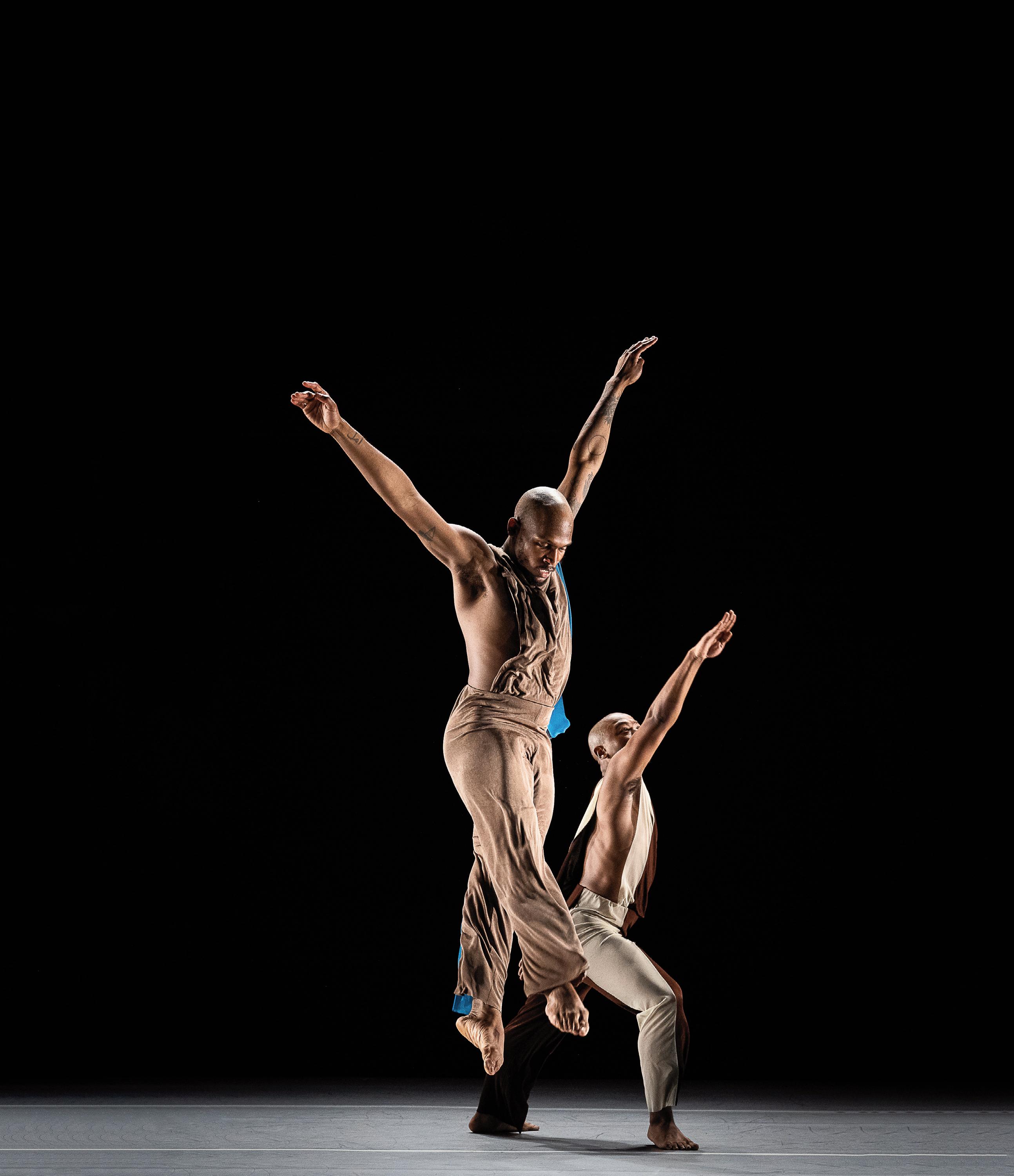




... and décor that makes a statement
PASTA FROM SCRATCH
HOW TO BREATHE
DREAMING OF PARIS





































































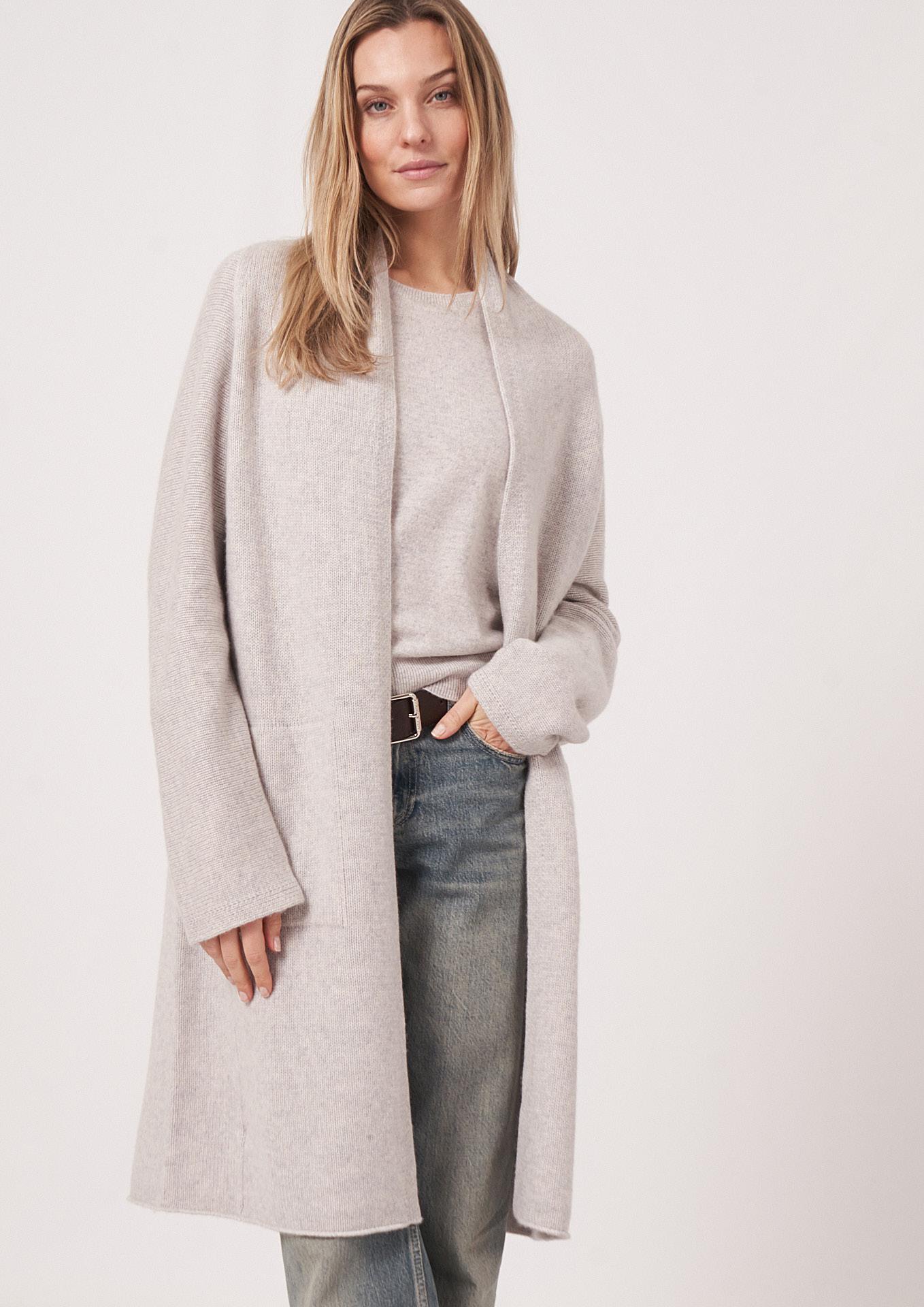
by


Power suits and punchy plaid: We round up the runway looks you’re going to love for FW24.
By Joanne Sasvari
How to make a statement — but also make it modern.
By Nessa Pullman
58
The YAM guide to solving the mid-week dinner dilemma.
By YAM Staff
62 Breathe Easy
Inhale. Exhale. Now do it again. We show you how breathing can boost mental and physical health.
By Alex Van Tol
76 Paris When it Drizzles
Why you should visit the City of Light — or anywhere — during the calm, quiet off-season.
By Joanne Sasvari



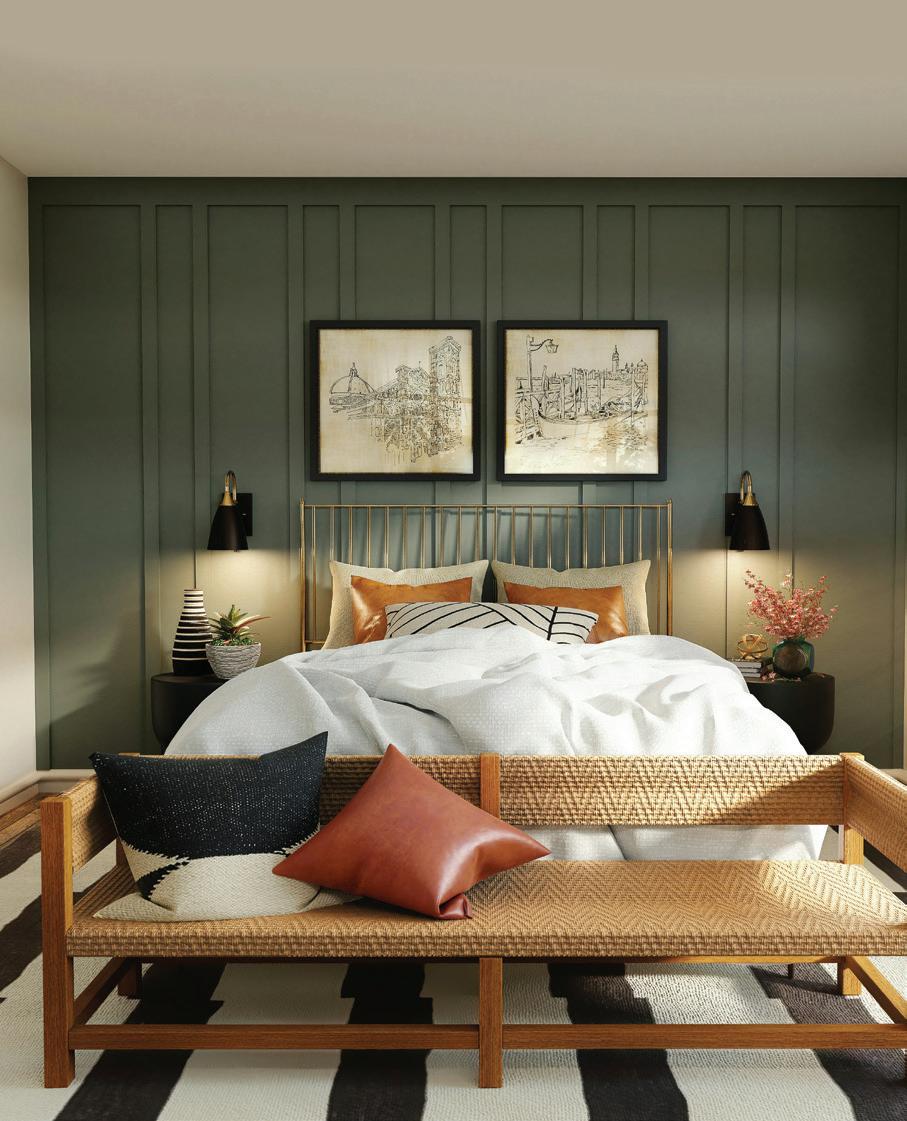

15 HERE + NOW
Developer-turned-antiquehunter Lenny Moy’s vintage finds for Rosemead House; top makeup looks for fall; the perfectly petite St. Evans Hattery; design books; where to play pickleball; a cool mini fridge. Plus: The YAM contest.
20 IN PERSON
Opera star Marion Newman returns home to teach at UVic and give Indigenous culture a beautiful new voice.
By David Lennam
34 STYLE WATCH
We’re wild for western-style denims, prairie dresses and wide-brimmed hats.
Styled by Janine Metcalfe
42 LIFE AT HOME
A basic condo transforms into a minimalistic space perfect for entertaining.
By Danielle Pope
65 FOOD + DRINK
Apple season; Tom Moore’s new cookbook; Esquimalt’s hot new Janevca; foraging tips; a guide to making pasta from scratch; why you should love Gamay. By Cinda Chavich, Joanne Sasvari
80 SCENE
For Atomic Vaudeville, life’s been a cabaret for 20 years. Plus: Culture Calendar. By David Lennam
Look closer: It’s spooky how much we love bats.
By Joanne Sasvari




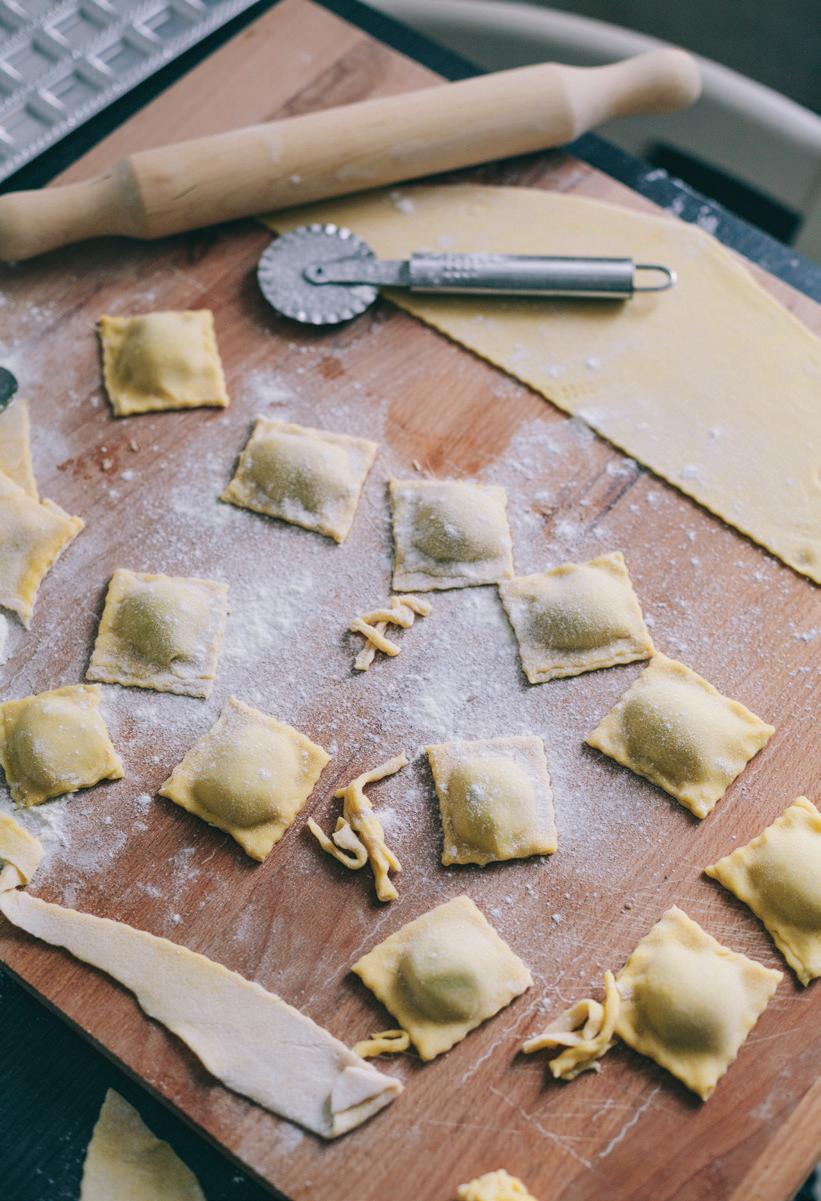


Not simply a matter of style but an art of love, fashion should celebrate the marrriage of a garment and a woman’s body.




ometimes, when the world is too much with me, as seems to be the case a lot these overly newsy days, I like to take a break and just look at pretty things. They could be anything, really, although the Pinterest algorithm tells me it’s mainly country gardens, paint colours in soothing green-grey-blue hues and French girl fashions. (No, you really can’t have too many Breton-striped Ts or ballerina flats.) That’s one way to define personal style, I suppose. It’s who you are when nobody is
Then again, style is also how we tell other people who we are, or maybe who we back in 1980, it was meant to be a spoof of the WASP-y set in the northeastern U.S.; plenty of people, however, took it as a how-to for fitting into an aspirational social group. (Madras! Izod! Topsiders!) Two years later and on the other side of the pond, The Official Sloane did the same thing for Princess Di wannabes. (Laura Ashley! Wellies!
Style, then, is a way to identify members of your social group, those who fit in, those who don’t and those who are trying way too hard or maybe not hard enough. And it’s not just about clothes. The other day I was talking with a friend about that knockoff Herman Miller office chair you see everywhere these days. “I can always tell when it’s fake,” she said. “I know,” I replied. “But mostly because I had one and it hurt my back.” We laughed, because when you know, you know, but also because we were
Style isn’t fashion, though it can be. Style isn’t always pretty, either. Style is something you grow into. Rare are the Cher Horowitzes and Ferris Buellers in real life, teens who have that innate grasp on who they are and don’t care what the crowd tells them is in fashion. For most of us, youth is for trying on different personas along with, say, different cuts of denim. In your 20s, you may wonder: Am I punk or preppy? Fluevog or Ferragamo? Basic bootcut, skinny low-rise, ultra-wide-leg or a nice,
As you grow older, you just know when that skinny jean is a poor idea. But — and I’ll


Joanne Sasvari, Editor-in-Chief editor@yammagazine.com








PUBLISHERS Lise Gyorkos, Georgina Camilleri
EDITOR-IN-CHIEF Joanne Sasvari
DIRECTOR OF PHOTOGRAPHY Jeffrey Bosdet
LEAD GRAPHIC DESIGNER Janice Hildybrant
ASSOCIATE GRAPHIC DESIGNERS Kelly Hamilton, Caroline Seggones
ADVERTISING CONSULTANTS Deana Brown, Jennifer Dean Van Tol, Cynthia Hanischuk, Brenda Knapik
ADVERTISING CO-ORDINATOR Rebecca Juetten
MARKETING & EVENTS
CO-ORDINATOR Lauren Ingle
FASHION EDITOR Janine Metcalfe
CONTRIBUTING WRITERS Cinda Chavich, Nessa Pullman, David Lennam, Danielle Pope, Alex Van Tol
PROOFREADER Lionel Wild
CONTRIBUTING PHOTOGRAPHERS Jody Beck, Simon DesRochers, Michelle Proctor
CONTRIBUTING AGENCIES Getty Images p. 12, 18, 62, 64, 73, 74, 77; Living4Media p. 56; Pexels p. 53, 54, 55; Stocksy p. 16, 26, 65, 72; Unsplash p. 52
1023 Fort Street, Victoria 250.920.7653 Mon-Sat 10-5 | Sun 11-4 heartandsoleshoes.ca contact@heartandsoleshoes.ca Heart and Sole Shoes heart_and_sole_shoes

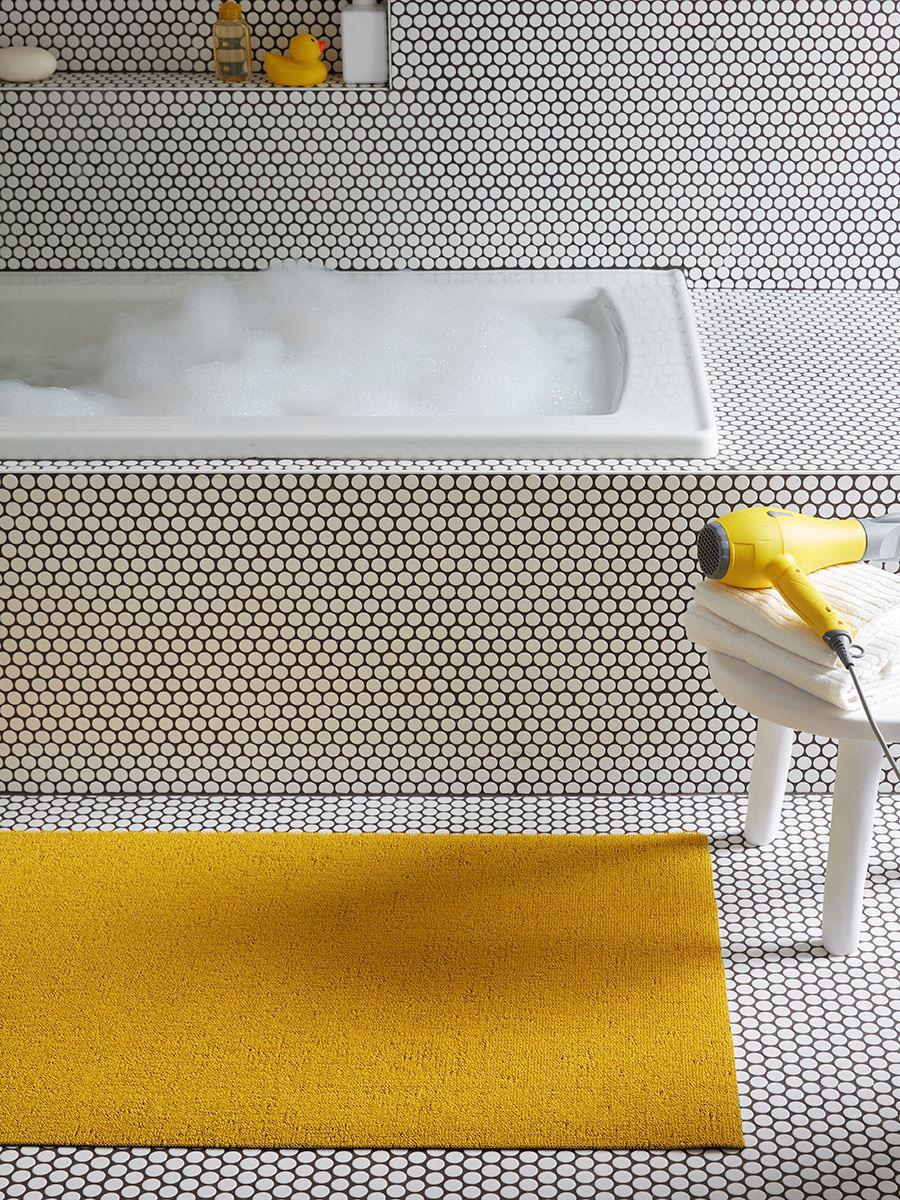
GENERAL INQUIRIES info@yammagazine.com
LETTERS TO THE EDITOR editor@yammagazine.com
SUBSCRIBE TO YAM subscriptions@yammagazine.com
ADVERTISING INQUIRIES sales@yammagazine.com
ONLINE yammagazine.com
INSTAGRAM @yam_magazine
FACEBOOK YAMmagazine X YAMmagazine


ON THE COVER Style Watch, p. 34
Published by PAGE ONE PUBLISHING
580 Ardersier Road, Victoria, B.C. V8Z 1C7 T 250-595-7243 info@pageonepublishing.ca pageonepublishing.ca
Printed in British Columbia by Mitchell Press. Ideas and opinions expressed in this publication do not necessarily reflect the views of Page One Publishing Inc. or its affiliates; no official endorsement should be inferred. The publisher does not assume any responsibility for the contents of any advertisement, and any and all representations or warranties made in such advertising are those of the advertiser and not the publisher. No part of this magazine may be reproduced, in all or part, in any form — printed or electronic — without the express permission of the publisher. The publisher cannot be held responsible for unsolicited manuscripts and photographs. Canadian Publications Mail Product Sales Agreement #41295544
ADVERTISE IN YAM MAGAZINE
YAM is Victoria’s lifestyle magazine, connecting readers to the distinctive lifestyle and authentic luxury of the West Coast. For advertising info, please call 250-595-7243 or email sales@yammagazine.com.

In his wildest dreams, Lenny Moy never expected to find himself hunting for antiques across the U.K., but here he is, some 50 auctions and estate sales later, with a warehouse full of vintage dishware, furniture, drapery and artworks. They are destined for Rosemead House, the grand Esquimalt mansion he spent the last six years and $13 million renovating. As president and founder of Aragon Properties, Moy is better known for his contemporary builds, but fell in love with the circa 1906 Samuel Macluredesigned property that Victorians likely remember as the Old English Inn. This fall, it will fling open its doors as a 29-room boutique hotel with a ridiculous amount of charm, character and unique pieces handselected by the proprietor.
“I’m a custodian,” Moy says. “We are all travelling through time and some properties are here forever.”
For a sneak peek at Janevca Kitchen and Lounge, the restaurant at Rosemead House, see page 66. rosemeadhouse.ca
When it comes to makeup, fall 2024 is not exactly a subtle or understated season. It’s all dark smudgy eyes, bright crimson lips and feverish cheeks, a mashup of ’90s nostalgia with a touch of the wide-eyed ’60s and punk ’80s. Here’s what you need to go from ladylike swan to sultry rockstar.

For everything from ladies-who-lunch elegance to doll-like drama to hard-core grunge, the essential tool for fall is a black eyeliner. (If in doubt, a subtle cat eye will take you almost everywhere.) We especially like the versatility of today’s intensely pigmented, easy-toapply and long-lasting gels, which can produce either a sleekly defined line or a perfectly smudged one. Try: Gel eyeliners from Bobbi Brown, MAC Cosmetics and Laura Mercier.
This season it’s all about the smoky eye, a look that’s a little messy, a little rock ’n’ roll and seemingly effortless. Use layers of dark, smoky, earthy tones of brown, grey and black to create a sultry, lived-in look with more than a nod to ’90s grunge. Soften it up for day then, for evenings out, go deeper, darker and sparklier. Pair with skinny, natural-looking brows. Try: Diorshow Mono Couleur, Charlotte Tilbury Luxury Palettes, MAC Dazzleshadow Extreme.
Everyone in fashion was talking about the 1960s-inspired doll-like makeup at the Marc Jacobs show, where giant fake lashes were coated in black nail polish for a super-spidery look. Too much for you? For more accessible drama and volume, get out the lash curler, invest in some volumizing mascara and start practising your falsie-application technique. Try: Lilly Lashes or Ardell Duo Professional falsies; Too Faced Better Than Sex, Tarte Maneater or Estée Lauder Turbo Lash mascaras.

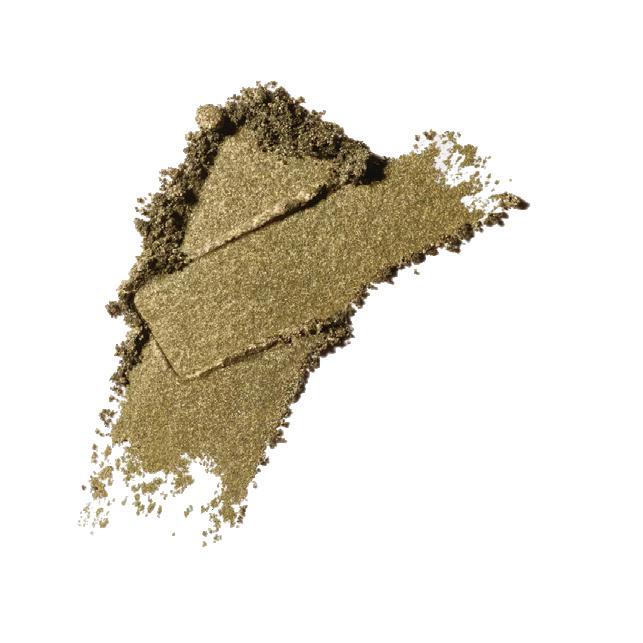
Fall’s power suiting demands an equally powerful lip, and that means all the saturated hues of crimson and scarlet, for day or night, casual or dress-up. A red lip suits fall’s retro vibe as well as it does the season’s cheeky “mob wife” esthetic, and is both classically cool and shockingly modern. Matte, glossy, ombré, orangey-bright or dark and winesoaked — it’s all in style right now. Try: Nars Powermatte Lip Pigment Liquid Lipstick in Light My Fire, MAC Cosmetics Retro Matte Liquid Lipcolour in Feels so Grand, Rouge Dior Forever TransferProof Lipstick in Forever Dior.

Of course, the season’s punk/ grunge/doll-like drama isn’t for all of us. You may just want to look like yourself, but a tiny bit more polished. Consider a capsule collection of balanced, semi-matte foundation, glossy nude lips and barely-there eye makeup by a brand known for its cruelty-free and sustainable practices. Now that’s beautiful. Try: The refillable capsule palette by Victoria’s own Elate Beauty, which can be filled with 16 pressed powders, including Brow Balm, Blush Balm in Wonder and Pressed EyeColour in Earthen. elatebeauty.com

We’ll all be wearing a healthy glow this fall, swirling blush on the apples of our cheeks and sweeping it right up to our temples. Think pink and girlish, and channel the doll-like 1960s and wholesome 1970s. The look isn’t as “glazed” as it was in spring, but more natural and semi-matte, thanks to the technically advanced new cream and liquid blushes. Try: Charlotte Tilbury liquid blush, MAC Cosmetics Glow Play Cushiony Blush, Nars The Multiple.


Doff your chapeau to the itty-bitty St. Evans Hattery.
When it comes to stylish hats, Chris Stevens has got you covered. She’s the owner and hatmaker at St. Evans Hattery, located at 569 Johnson Street, Unit A, in what might just be the world’s tiniest store.
All her chapeaux are variations on the fedora, crafted from fur felt and custom-made for the person who plans to wear it. “People’s heads vary very, very widely,” she says. “North Americans tend to have avocadoshaped heads — depending on your lineage, you can have a different shaped head. Looking at people’s head shapes, it’s crazy how different they are.”
She adds: “I personally do a lot of asymmetrical shapes; that’s what I’m drawn to. If you make a hat asymmetrical, it makes the person under it look more symmetrical, which is what we find pleasing.”
Stevens came to hatmaking about six years ago, after a career in tailoring. She was craving a more immediate sense of creative satisfaction than she was getting from making suits, which take about 180 hours to complete. She was also looking for a hat that would fit her “unusually small head.”
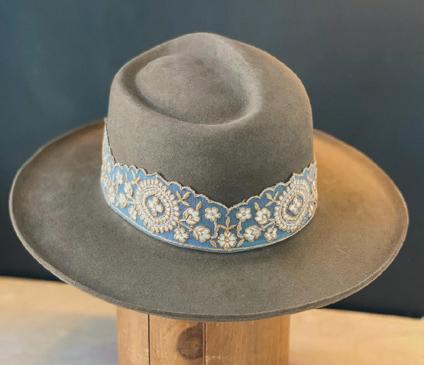

She found herself making more hats than she could ever wear, so she began selling them at farmers’ markets. Sales were so brisk, despite a price tag that can range from $350 to $1,500, that she quickly realized she’d need a store. Just not a very big one.
A “friend of a friend” found the four-by-10-foot space on Johnson Street; two weeks later, at the end of May, she moved in. She carries no inventory aside from a few samples, and makes her hats right on the premises.
But is it really the world’s tiniest store? “As far as I can tell, it’s definitely the smallest hattery, and searching Google, the smallest store I can find was 50 square feet in New York,” she says. St. Evans, by contrast, is a petite 40 square feet. But Stevens doesn’t mind. “The space works quite well for me.”
If these new releases are anything to go by, it’s going to be an eye-catching fall season.
Introduced and edited by Susan Mertens (Figure 1 Publishing, with the Audain Art Museum, October)

This intimate and candid memoir uses poems and excerpts from Shadbolt’s personal journals, letters and other writings to tell the interior story of one of Canada’s most important modernist artists, who was deeply inspired by his years living on the West Coast. This is the memoir Shadbolt (1909-1998) never quite got around to writing.
By Diane Keaton, introduction by Ralph Lauren (Rizzoli, September 3)

Movie star. Fashion icon. Witty raconteur. Keaton offers an ode to her favourite looks over the years (and some she wasn’t so fond of). Her signature Annie Hall style is here, along with everything from the homemade ensembles she wore as a child to her glitziest red-carpet moments. Gossipy, glam and filled with a stylish who’s who.
By Dominic Bradbury (Phaidon, October 8)

For anyone who can’t get enough of the architecture of the 1950s through ’70s, this beautifully photographed book might just satisfy those cravings for clean lines, big windows and painted concrete breezeblocks. It features 450 of the very best mid-century works on every continent, from skyscrapers to churches, embassies, office blocks, transport hubs and swimming pools.

Find more courts — and friends to play with — than ever before.
Pock. Pock. Pock. The sound you hear is the fastestgrowing sport in North America, one that has a momentum that just won’t quit. We’re talking, of course, about pickleball.


It’s a racquet sport that’s easy to learn and easy to play, but can get competitive fast, which also makes it lots of fun. Invented on Bainbridge Island in 1965 as a sort of cross between ping-pong, tennis and badminton, over the last 60 years pickleball’s popularity grew slowly and then, around 2018, simply exploded. In a January 2023 study, it was estimated that more than 1.37 million Canadians were playing pickleball at least once per month, up 50 per cent from just a year earlier. Heck, you probably play pickleball yourself.
So pickleball isn’t news. What is news is the number of pickleball courts being built to accommodate all of Victoria’s many pickleheads. Two new courts recently opened at Uptown, near Brown’s, but there are also four dedicated courts at McMinn Park, two at Tolmie Park and six at the Victoria Pickleball Centre in Langford.
The website pickleheads.com offers a guide to courts here and across North America, and has profiled more than 17,000 pickleball courts in 7,187 cities, including Victoria. It also connects players across the continent, offers instructional videos, provides advice on gear and more.
Players can also join — or start! — a pickleball club. Learn more at pickleballbc.ca.

One lucky winner will take home a $500 gift card from Mayfair Shopping Centre, just in time to stock up on all the beautiful new fall fashions.
After all, Mayfair is all about fashion. It features dozens of regional, national and international retailers, as well as a vast array of shopper-friendly services, and is conveniently located at the key commuter routes in and around the City of Victoria. It’s the perfect place for your seasonal style update.
To enter, visit yammagazine.com or scan the QR code. Contest closes October 25, 2024. Good luck!
For when your space is small, but your style is grand.
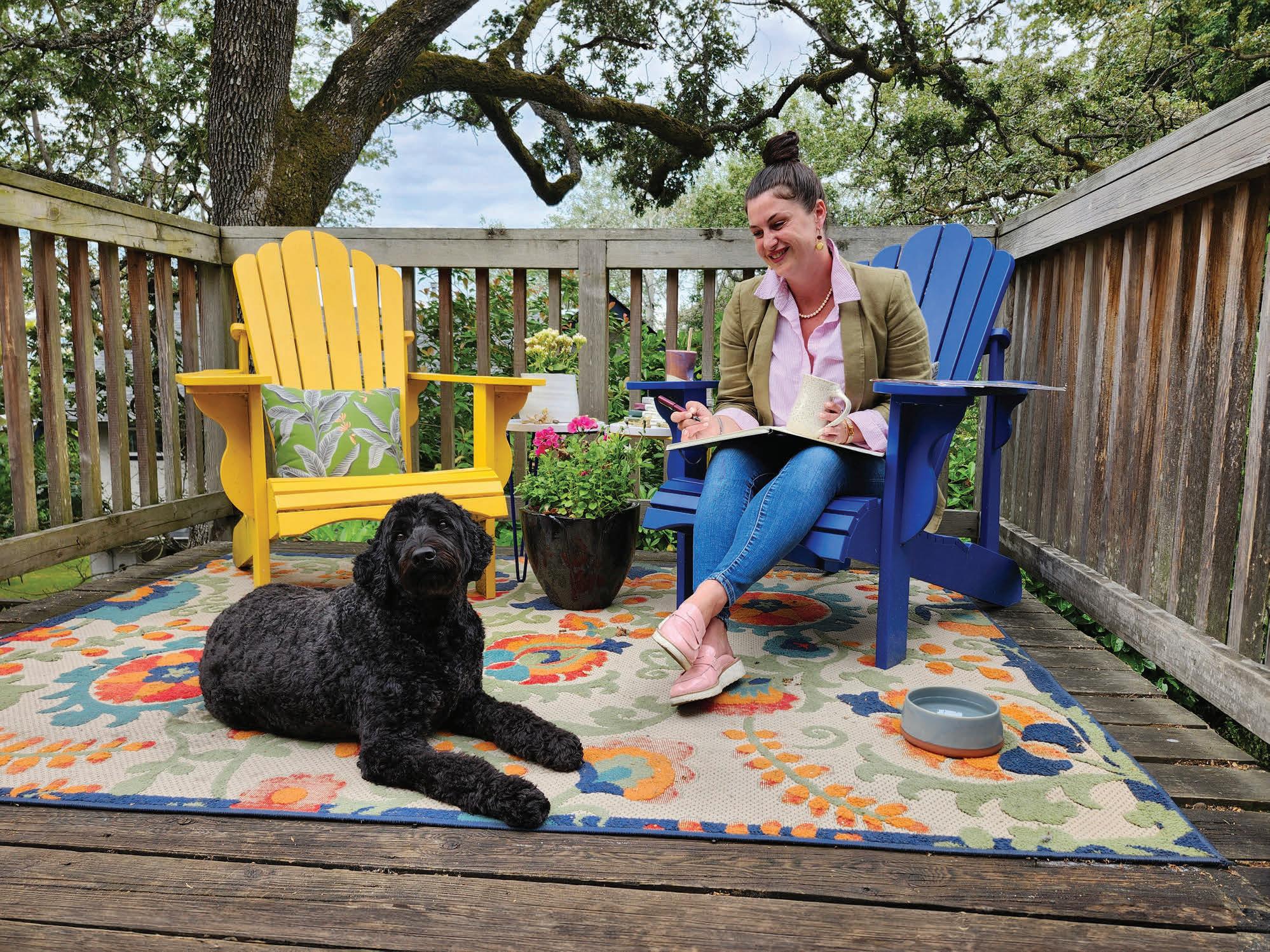

There comes a time in every life when you need a mini-fridge. Maybe it’s for your kid’s college dorm room — or your own. Perhaps you need it for a man cave or she shed or whatever we’re calling those spaces these days. It might be for a rental unit, an outdoor kitchen, an office or because you need somewhere to stash the wine while your kitchen is being renovated.
Whatever the case, why not choose something cute, fun and vintage inspired, but still useful? Something like a retro mini fridge from the U.S.-based company Galanz. They come in different sizes, from 2.5 to 4.4 cubic feet, and a handful of mid-century hues, including the adorable Bebop Blue (see below). There’s also a microwave that will totally trigger nostalgia for your childhood Easy-Bake Oven.
Now, you may think these look an awful lot like a certain other retro line that comes from Italy, and they do, but at a fraction of the price. Now that’s cool. galanz.com




By David Lennam |

Marion Newman has returned home. The Kwagiulth and Stó:lō First Nations mezzo-soprano is back in Victoria where she began.
And damned be the sentiments of poets about never returning home again. Home may have become a different place, but when you’ve been away for 24 years, you change, too.
For Newman, who has fashioned a career on the international stage as well as hosting CBC Radio’s popular Saturday Afternoon at the Opera, the homecoming was precipitated by an offer from the University of Victoria to join the faculty as assistant professor in the school’s music department.
“I can’t think of a better way to return to where I came from,” says UVic’s 2022 Distinguished Alumni recipient. “As an Indigenous person I really do come from a ‘place.’ When I first moved to Toronto I had this weird feeling I’d forgotten my Indigeneity and my traditions. It dawned on me shortly thereafter that was because I was not of the culture that is there and nothing felt familiar because it wasn’t. It’ll be wonderful to be close to that again.”
Apart from instruction, Newman will provide a First Nations perspective that aligns with the university’s new Indigenous Plan (called Xwkwənəŋ istəl | ENE ISTEL |), with its ambitious goal of embedding Indigenous ways of knowing, being and learning into programs, systems and organizational structure.
you come back home. You’re now teaching your people, your cousins, your aunties’ daughters. It’s a big deal to come back and teach at UVic.”
The position allows Newman to openly share her differing perspectives and experiences. And culture.
“I can help make that whole faculty a little more welcoming to people like me. And I can make sure there’s no more person saying, ‘Well, we have to let you in because you’re an Indian.’ ”
She’s heard that before. And more. Even about being “not Indian enough” when playing an Indigenous role.
Sometimes working on operas in Europe, her Indigenous background gets more than a cocked eyebrow.
“There literally are people who don’t think we exist anymore. I have met people who are like, ‘Oh, I didn’t realize there were any Indigenous people left in Canada.’ ”
She’s been asked about whether or not she has to pay taxes and, though admitting it doesn’t happen as often anymore, the notion gets raised that somehow she’s more connected to the Earth.
“Opera is for stories that are too big to be read or said. They need to be sung out loud.”
UVic isn’t just hiring a voice teacher, albeit one with years of experience on the international stage. The university is also getting someone ready to do the hard work of bridging Indigenous and non-Indigenous worlds, perhaps towards Indigenizing classical music.
Newman says that is more about the process of how the music is made and rehearsed and put in front of an audience — the consideration of how people are treated and who has a voice in the decision making.
“That’s something I’m really interested in and want to bring into the classroom and the studio is how we respect each other, how we say what we need to say and how we make decisions and how we take responsibility for what we’re putting up as a collective.”
Carmen Thompson, Newman’s costume designer for the opera Missing — the story of missing and murdered Indigenous women in B.C., which premiered at Pacific Opera Victoria in 2019 — understands how the singer fits in as a role model.
“I’m excited for her,” says Thompson, who is herself of Ditidaht/Kyuquot/Coast Salish Nations background. “The role model part of her is quite big. And there’s the weight of who you are when
Perhaps opera, even with its elitist and Caucasian roots, can be an act of reconciliation. This was Newman’s experience in Missing, created by Métis playwright Marie Clements and Junowinning composer Brian Current who, she says, had nothing to do with each other’s worlds before collaborating.
“It was really amazing to witness their friendship growing, their figuring out what questions they can ask … and their trust growing in each other and the respect given each other. It was really beautiful,” Newman says. “That is a huge act of reconciliation and I’m glad I got to witness it. It really changed Brian Current. He now conducts quite differently based on that experience.”
Thompson adds that it was refreshing to work with someone like Newman who understood her Indigenous female artist family protocol voice.
“That gave weight to her as a performer. And I really admire the performers who make sure they have all the boxes checked in a way.”
Growing up home-schooled in Sooke, in a family of teachers and artists (her father Vic and brother Carey are both master carvers), Newman was pianist before singer. But it’s her voice that provided a solid career.
“Voice really opened up a beautiful world of relating to others through words, through acting, through inhabiting other characters,” Newman says. “I was very shy and so being able to play other characters, being able to always be collaborating with people — you don’t do solo recitals all by yourself the way you do with piano — it’s just a wonderful way to become

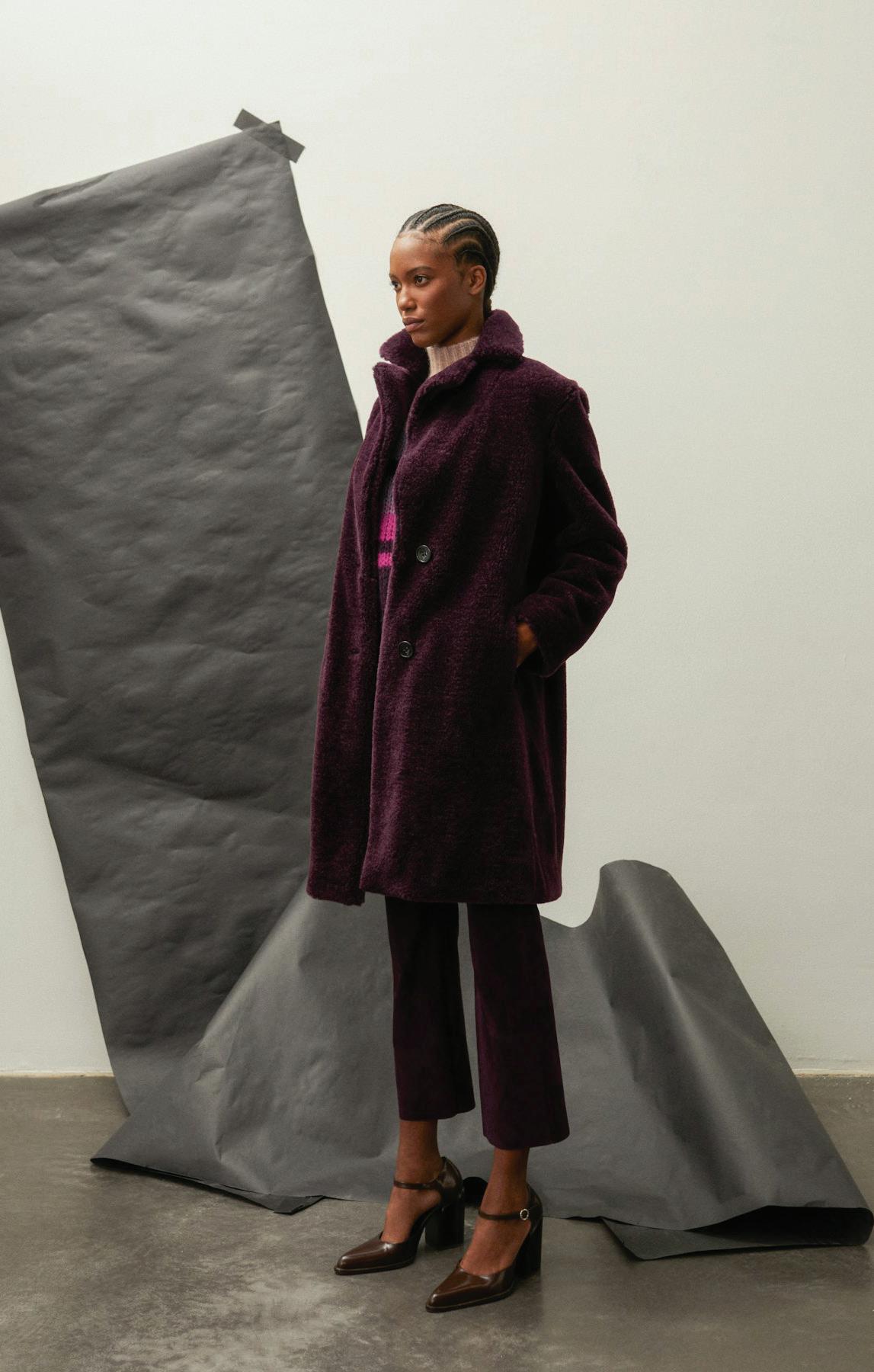

more social and to start finding my words and to take some of the weight of the performance off of just me by sharing it with a whole cast of people.”
If there’s a coda to Newman’s return engagement to Victoria, it’s a few words she once left with Pacific Opera and said they could borrow. They have. It’s this: “Opera is for stories that are too big to be read or said. They need to be sung out loud. It reaches inside you. The music pulls at your heartstrings. And you go away being changed by that story.”
Catch Saturday Afternoon at the Opera weekly from 1 to 4 pm on CBC Music. Look for Marion Newman as Maddalena in Rigoletto next April, her sixth appearance with POV.
What do you want people to know about you?
“I really love to laugh. I want people to know about the joyful and hilarious side of Indigenous people so they’re not pitying us. We’re still here for a reason and that’s because we’re really frickin’ hilarious.”
How do we get younger people to go to the opera?




















“We might have to wait till they’re old. [She laughs.] I didn’t want to watch opera when I was little. I didn’t want to listen to it. Saturday Afternoon at the Opera would come on the radio and I would go outside to play. It’s funny that I’ve ended up doing this and that I love it so deeply now.”
If you weren’t singing opera, what would you be doing?





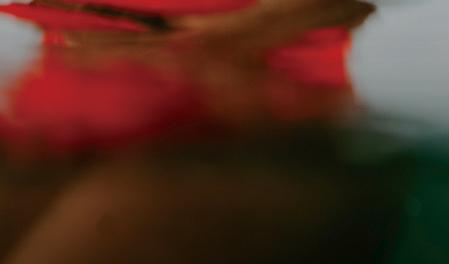

“I would be sewing things. I would be involved in food, especially the eating of it. Tasting things.”
Ever wish you weren’t a mezzo?
“Yes, whenever I hear the ‘Song to the Moon’ from [Antonín Dvořák’s] Rusalka. I really want to sing that aria. It sits just slightly too high for me to sustain easily.”
Who’s your favourite opera character?
“I would play Rosina [from The Barber of Seville] any time. That’s such a fun role, she’s so full of mischief and smarts. I would play Dr. Wilson [from Missing] any time even though it’s pretty heart-wrenching. Playing Dr. Wilson has made me realize a lot of cool things that I like about myself. And every time I play that role again, I learn more. I learn how to be a better person.”




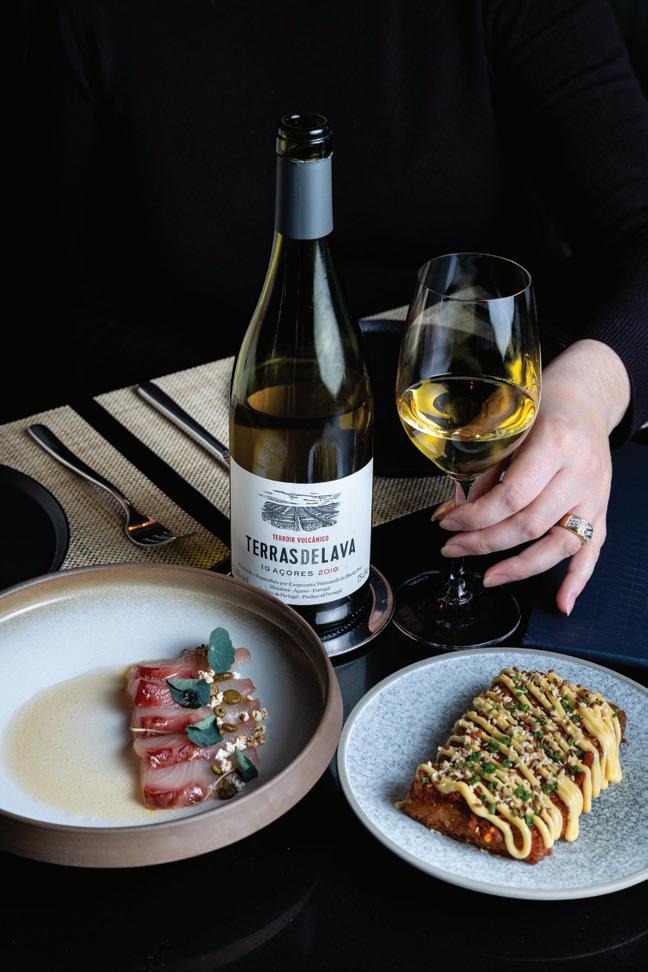






Autumn’s golden light feels different in Tofino. Sunrise beach walks, seafood harvested steps away, a memorable day trip to Hot Springs Cove... Simple pleasures come easily here.
The energy is palpable, whether it instills adventure, relaxation, or a deeper sense of reflection. Feel the connection to the land and sea in the Clayoquot Sound UNESCO Biosphere Region, with the sand beneath your feet and the wind in your hair.
Tourism Tofino extends our heartfelt gratitude to the ƛaʔuukʷiʔatḥ (Tla-o-qui-aht) and ʕaaḥuusʔatḥ (Ahousaht) First Nations for the privilege to work, learn, and welcome visitors on their unceded territories that they have stewarded for millennia
















Forget yesterday’s insta-trends. This fall, fashion is all about beautiful clothes that are made to last — and suit us just the way we live.
By Joanne Sasvari
Over the last few years, fashion has veered from all-sweats-all-the-time during the pandemic lockdowns to one TikTok insta-trend after the other. Remember nap dresses? Cottagecore? Head-to-toe Barbie pink? Quiet luxury? Y2K nostalgia? Underwear as outerwear? Cargo pants? Sheer everything? The unfortunate return of the Canadian tuxedo?
So, if you’re anything like us, you’ll be thrilled to know that fall 2024 is a season of beautiful, wearable, wellmade fashion that suits you, whoever you are or wish you were.
We’re seeing a return to high-quality and well-tailored pieces that are designed to last, what we used to call investment dressing, which also fits nicely with the frugal mood of the moment. But that doesn’t mean old-fashioned “classics” and it certainly doesn’t mean boring.
Take the power suit. It’s back in style, but this time it’s not dowdy, beige and worn with pussycat bows and practical pumps. Instead, it is the easiest way to look pulled together, whether for the office, an after-work event or even for travel.
“I have just bought myself a couple of power suits and will wear them all winter,” says Janine Metcalfe, YAM’s fashion editor. Suits, she adds, are endlessly versatile, especially when they are oversized and bring the drama. “You can dress them up with a crisp white shirt and a high heel, or a more relaxed look with a pair of sneakers. Love this look for fall.”
At the opposite end of the style spectrum is the return of bohemian chic, largely thanks to Chloé’s barnstormer of a runway show. “Boho chic has made a bold return and I love it. Flowy fabrics, from sheer to printed, and I’m a big fan of fringe and ruffles,” says Metcalfe.
She’s also loving the sage green that was all over the runways. “I love that sage also represents wisdom, intelligence and experience,” she says.
Best of all, even everyday pieces are getting a stylish reboot. “No longer are closet essentials like my everyday hoodie and my basic tee considered basic — they’ve melded into showstopping pieces like at Balenciaga,” Metcalfe says. “I’m so happy that this look isn’t going anywhere, [it] just gets more elevated.”
In other words, it’s never been easier to leave the house looking good. Here are the runway trends that will be inspiring us this fall.


Whether structured, fitted, oversized or deconstructed, sharply tailored looks were all over the FW24 runways, especially in the form of luxurious overcoats, beautifully made blazers and (hooray!) the return of the power suit. They were deconstructed at Schiaparelli and trimly tailored at Prada; meanwhile, Tom Ford showed a parade of fitted, buttoned, military-inspired coats, jackets and dresses. Voluminous overcoats were everywhere, too, in gorgeous textures from sleek leather to teddy-bear bouclé to feathers and fringe. And if there was one look we’ll all be adding to our closets this season, it’s the perfectly timeless take on the peacoat shown by Tom Ford, Miu Miu, Etro and others.
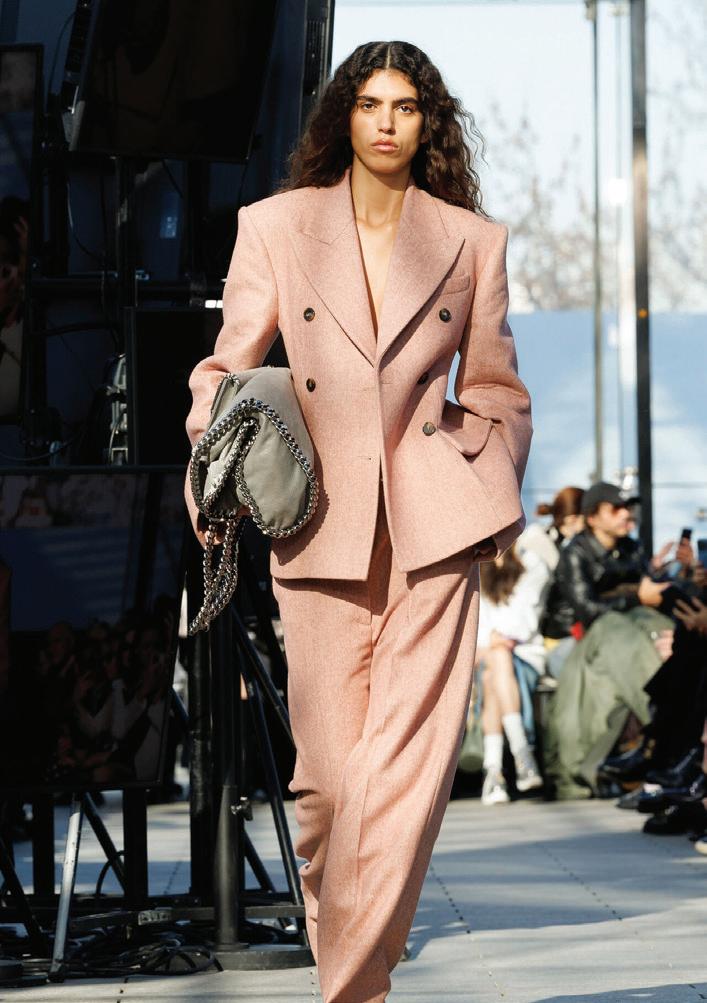
Balancing out all that tailoring and ladylike dressing was the roaring comeback of boho chic, mainly thanks to Chloé’s blockbuster show. The label’s new creative director, Chemena Kamali, created a collection that is fresh, joyful, romantic, indulgent, a little bit artsy and a whole lot of fun. It’s everything that understated, so-safeit’s-boring “quiet luxury” isn’t. Look for intricate details and a touch of early noughties nostalgia: sheer dresses, lace hosiery, fringe, romantic ruffles and toughbut-sweet black leather.


The critics may have given Ryan Murphy’s latest Feud: Capote vs. the Swans the side-eye, but designers simply swooned over those luxe mid-century fashions — and so did we. Now we have a cooler, more contemporary take on those ladylike looks. Think: shift dresses, swing coats, cashmere cardigans and flared below-the-knee skirts, but with a more fluid and more casual vibe than back in the 1960s. Among the looks we loved were the tweed twin sets at Erdem, vintage-style brooches at Simone Rocha, lady bags at Celine, full skirts at Valentino and Miu Miu’s entire collection.
We all need those essential but unglamourous everyday pieces — a perfect tee to wear under a blazer, a hoodie to toss on when we run to the grocery store, sweats for WFH days, jeans that take us everywhere. Designers get it and have given those basics a glow-up for fall with soft textures, simple fabrics, playful layering and exaggerated silhouettes. Just throw them on and go. But first, add a belt: Whether classic leather (Loewe and Dior) or gleaming in gold metallic (Chanel and Chloé), nothing will tie your look together as well.

Sure, you can snuggle up in fall’s traditional woollens and tweeds. But the hottest looks of the season are all about ultra-tactile textures, with designers bringing the drama with feathers, fringe and faux fur (see: Tory Burch, Stella McCartney and Alexander McQueen, among others), as well as fabulously fluid satin (at Ferragamo, Giorgio Armani and Victoria Beckham) and leather everywhere. Feathers especially took flight this season: on shoes at Erdem, sleeves at Christian Siriano, coats at Schiaparelli, evening gowns at Louis Vuitton.


This season, go big or go home. We love the chunky scarves and oversized knits (shown by designers like Tommy Hilfiger and Jason Wu), the padded shoulders and curvy hips, the bulbous coats, full skirts and bouncy dresses in fluffy yarns. But we especially love the season’s voluminous, wide-legged take on trousers, whether high-waisted at Loewe, elevated cargo style at Saint Laurent, barrellegged at Alaïa or tapered at Prada.


Given the state of, well, everything, we could all use some comfort right now, and fashion is here to help with cozy, comforting pieces in luxurious materials, perfect for covering up and hiding out from the world.
Consider: hoods (at Balmain, Nina Ricci, Alexander McQueen); high-necked coats (at Burberry and Max Mara); double layers (Gucci’s layered brown cardigans); and swathes and swathes of fabric in giant capes, chunky scarves or sweeping shawls. Knitwear is huge right now (both figuratively, as in, there was a lot of it, and literally, as in oversized silhouettes).
Consider both the cardigan (whether ladylike bouclé at Chanel or structured at Stella McCartney) and the roll-neck pullover essential this fall.






It’s certainly not unusual to see earth tones in fall, but this year is notable for the wave of soft, dusty greens, all those flattering, easy-to-wear khaki, sage and olive hues inspired by both nature and military looks. Think lacy frocks and pea coats at Gucci, trench coats at Chloé and all over at Ferragamo, Burberry, Jil Sander and Bottega Veneta. Also, adding a rich, polished, wine-soaked note to all the neutrals and earth tones that otherwise dominated the runways, were the beautiful burgundy bags (from Gucci, Bottega Veneta and Ferragamo, among others).
This fall, designers went mad for plaid (wool overcoats at Chloé runway, blazers at Rabanne, black-and-white at Balmain). This is not exactly revolutionary; fall is typically the season for plaid, tartan and other checkered motifs. But this year it feels fresh and new, especially when worn as outerwear, wrap skirts and crewneck sweaters, and paired with clashing colours, patterns and textures.
Plaid not your thing? Then you might be thrilled to know that leopard print is also back in style. (Reports suggest a whopping 75 per cent more leopard on the runaways this season than last year, though we’re not exactly sure how they measured. Did they count the dots?) There’s nothing subtle about it, either — check out the big-cat energy of Christian Dior’s belted trench as well as pieces from Zimmermann, Alaïa and Versace. Rowr.


In everything from moto jackets to ’50s-style full skirts to head-totoe dressing, leather is the look that pulls everything together this season. Whether it’s real leather or vegan-friendly faux, look for a glossy, liquid-look finish. And while black is always in, this season look for blue, green or brown leather. Luxe yet tough, classic but contemporary, leather showed up in almost every label, in shirts, skirts, dresses, trousers, jackets, coats and, of course, handbags and other accessories.

No matter what trend appeals to you this season — preppy plaids, bohemian fringe, powerhouse tailoring — these are the essential items your closet needs.
If there is one thing you want to invest in this season, it’s a coat. But with so many gorgeous choices out there — among them, leather moto jackets, oversized greatcoats, military toppers, French-girl trenches and reimagined peacoats — how can you choose just one?
No longer the supporting cast to your going-out tops, pants this season are making their own powerful statement in voluminous cuts, flowing fabrics, high waists and the notice-me barrel-leg silhouette.
Ladylike, elegant, playful, fun and full of drama, the voluminous skirt is back. Flared, full, puffed and/or peplum, wear it with a trim lady cardigan or tough-girl moto jacket, and pile on the vintage brooches and pearls.
We’re always happy to see the return of sweater season and this is a good one, whether you prefer a tweedy twinset or chunky, oversized rollneck with padded shoulders. The key this year is layering, so don’t forget the shawls, scarves and capes.
That’s right: The ’00s are calling and pointy-toed, high-heeled pumps are back, worn with jeans, suits or evening frocks. So are tights. After a couple of decades of baring our legs to the wintery elements, this is the season to slip back into panty hose. Make them patterned, colourful or lacy. Then again, the ballerina flat is not going away any time soon, which is good news for your aching Achilles.



Over the last several seasons, there’s been something of a flamboyant, gender-bending esthetic in menswear. Think: Harry Styles’s oversized brooches and ruffled shirts, Billy Porter’s tuxedo-esque gown at the 2019 Oscars, Eddie Redmayne in a tulle frock at the 2024 Met Gala, Brad Pitt in a utility skirt at the Bullet Train screening in Berlin, Jared Leto in anything, anywhere. It’s not shocking — barely even surprising — any more.
So it seems about time for the menswear pendulum to swing back to a more conservative style — but this time, with sophistication and a cheeky bit of glam. The season is all about wearability, about proper suits, a nice cardigan, well-cut trousers and, yes, a tie. Here are five looks men will be reaching for this fall.

The west, it seems, is best, at least when it comes to the must-have trend for men this fall. Who doesn’t love fringe, denim, single-point pockets, tooled boots and a cactus motif? They were all over the runways, especially at the exceptional Louis Vuitton show designed by Pharrell Williams.
As with women’s fashion, menswear is all about proper tailoring this season, which means jackets, trousers and outerwear designed to last. But that doesn’t necessarily mean classic cuts — there are plenty of oversized shoulders, nippedin waists and deconstructed features, too. Check out the sleek, slimmed-down tailoring at Gucci and Prada, and the mid-centuryinspired looks at Dior Men.



The coat is the essential piece this season, and there are so many great choices to invest in, from Valentino’s sky-blue full-length duffle to Balmain’s bright pink overcoat to the more classic colours and cuts at Givenchy or Gucci. Wear it with a pair of high, thick-soled boots.
Feeling chilly? Not in these fur-ociously good looks. There are plenty of faux fur scarves, hats, trim and outerwear this season, but no one has gone on the prowl quite the way Giorgio Armani has. His Milan show featured leopard-print linings, jackets and a full-length zippered coat.

Much has been said of the return of the tie this season (narrow, subtle, old-schoolgentlemanly), but otherwise accessories have plenty of flair. Among them: XXLsized handbags, notably the Louis Vuitton Speedy, Prada tote and Valentino moon bag. At Vuitton, along with cowboy hats, there are also complementary turquoise gems in buttons, earrings and top-stitching on jeans. Balmain, meanwhile, showed off head jewelry and gilded hats. And brooches have made a comeback, especially at Fendi and Dolce & Gabbana.


Durability of design
Positive environmental impact (made from repurposed
Perfect for cooler days
Style!



Inspired by Beyoncé, but uniquely your own, today’s western wardrobe features denim, wide-brimmed hats, prairie dresses and widewale corduroy. It’s a look that’s as at home in the city as it is down on the farm.

This page: LUXE LEATHER

Opposite page: CORDUROY RETURNS
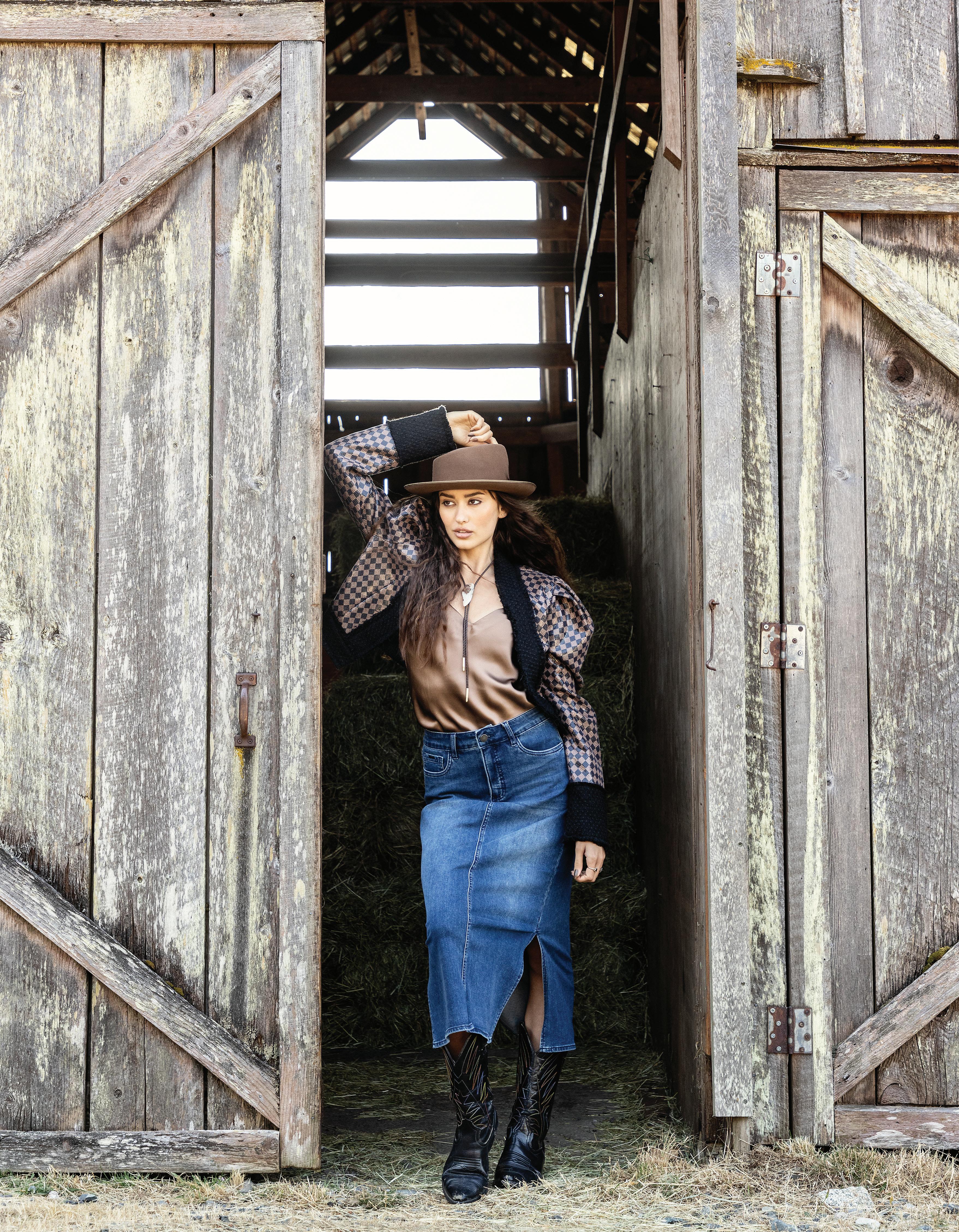
This page: DENIM FOR DAYS
Four-way stretch denim skirt by FDJ (French Dressing Jeans), available at Adventure Clothing. Dream silk top in Macchiato by Simone Pérèle, available at Mel Lingerie. Hat by St. Evans Hattery. Bolo tie, Project Wardrobe Rental House. Vintage jacket and boots, model’s own.
Opposite page: ROMANTIC FLORALS
Magnolia Ava dress by Smoking Lily, available at Smoking Lily. Jasper Hat by Tilley, available at Adventure Clothing. Boots, model’s own. Necklace, stylist’s own.


Lace blouse by L’Agence, available at Good Bones Clothing Company. Skirt by H&M, available at Project Wardrobe Rental House. Belt by Zara, available at Zara. Boots, model’s own.
Capo Olena skirt and shirt by Culture, hat by Ayrtight, all available at Moden Boutique. Belt by B.Belt, available at Bagheera Boutique. Bandana, model’s own.
On the cover: LAYERED LOOKS
Jacket, vest and turtleneck by Luisa Cerano, jeans by Raffaello Rossi and purse by Marlon, all available at Bagheera Boutique. Hat handmade by St. Evans Hattery.


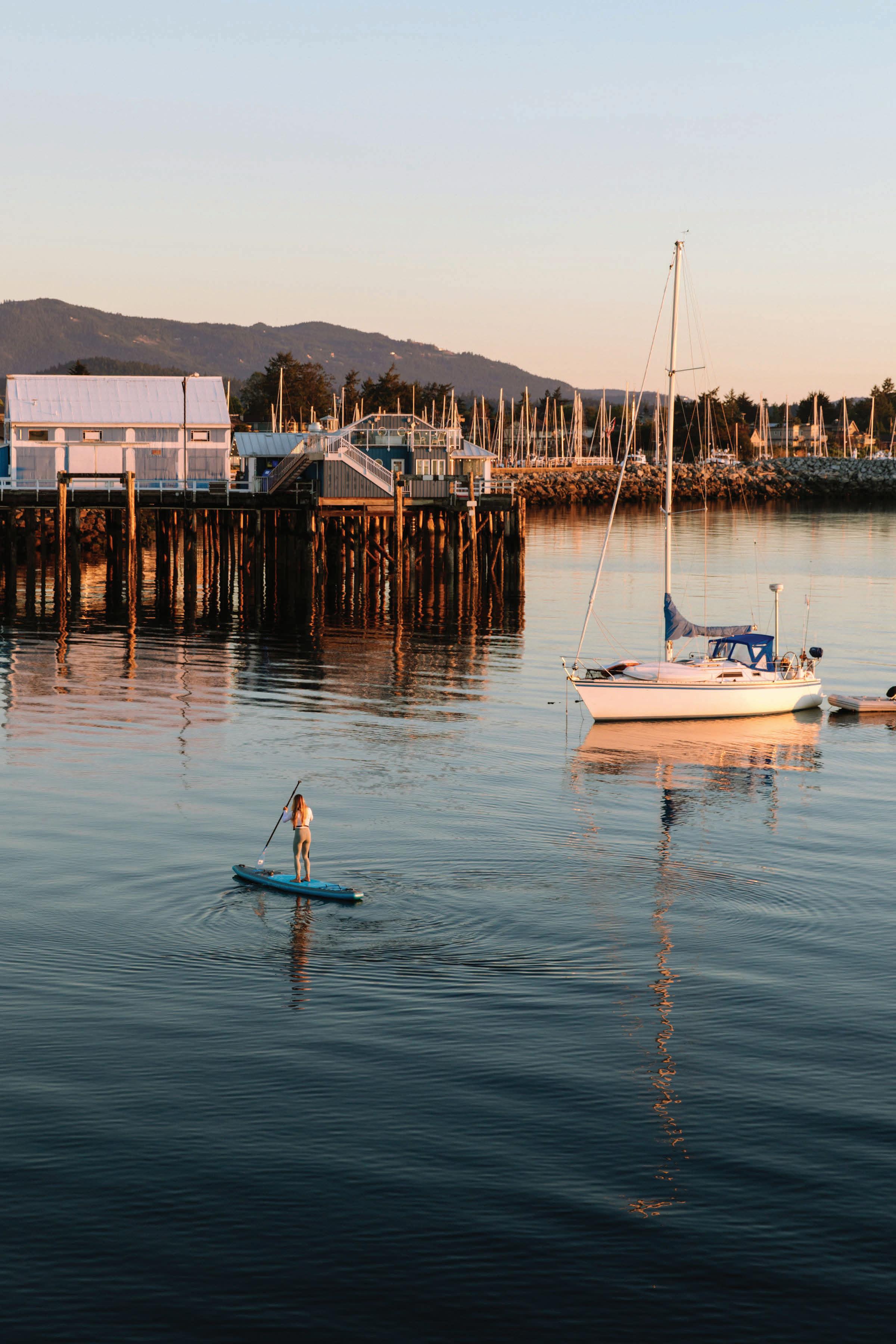
Situated at the shore of the Salish Sea, Sidney’s historic and vibrant downtown district is the heart of the Saanich Peninsula. Locally owned storefronts, coffee shops, eateries, and more offer unique and memorable opportunities year round.



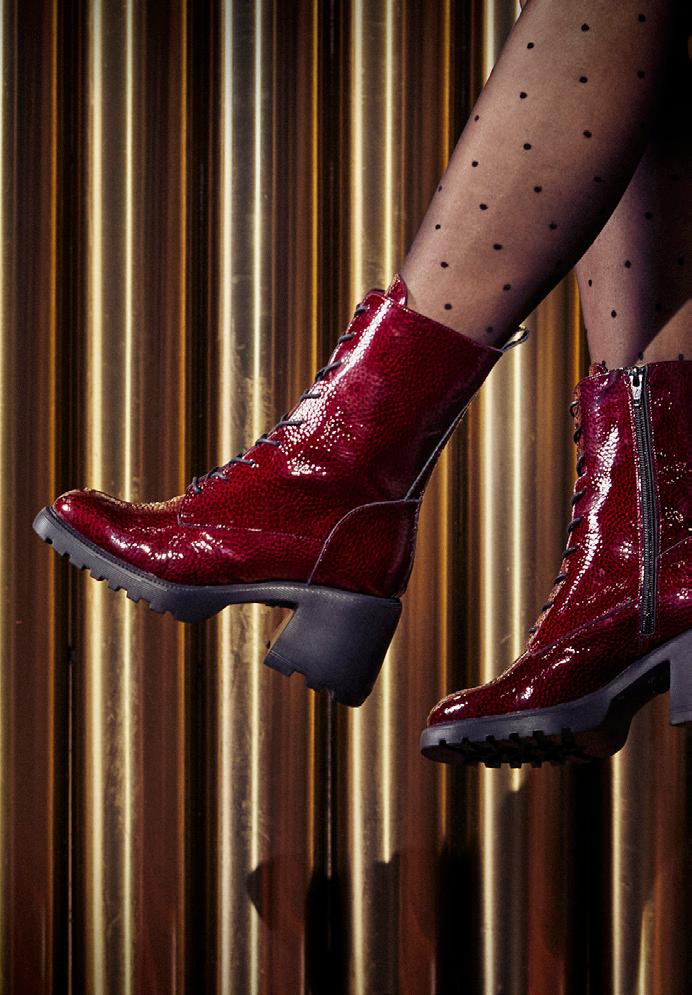










It took special skills to transform this downtown condo into a clean, contemporary space — without turning it into a “Swedish hospital.”
By Danielle Pope | Photos by Jody Beck

When David Choboter was looking for his next home, he wasn’t really considering a condo.
He’d recently sold his home on the water and was renting downtown, so he was ready for a space he could fully customize — one that had tonnes of light, a feeling of luxury and, most importantly, a kitchen made for culinary adventures.
So, it surprised Choboter as much as anyone that one particular penthouse in the downtown core checked most of those boxes. At least, it could with a few tweaks.
“It had great southwest exposure, a really large patio, and was very bright with tall windows — but the question was, could I turn this into what I wanted?” says Choboter.
With only himself and his dog to worry about at the time, Choboter took a chance. He knew the floor plan would need a rejig and he rejected the cookie-cutter appliances and standardized motif throughout the building.
“That’s when I started to look for a designer. I had some experiences with renos and design, but never had carte blanche,” he said. “This would be my first big palette to work with.”
Choboter enlisted the help of interior designer Pamela Billinghurst and the team from Aryze Developments. Thanks to their strategies, Choboter says the end result brought personality, form and function to what has become a completely new space.
“I basically wanted a Swedish hospital,” says Choboter with a laugh. “Pamela directed me away from something clinically dead and into something a little more white and lively.”
To her credit, Billinghurst took Choboter’s initially sterile inspiration and transformed it into a clean, minimal space that functioned as the true design feature of the home.
“We wanted to create a contemporary but urban minimalist lifestyle for David, so that meant clever storage and a really efficient layout,” says Billinghurst. “We were able to achieve that through some very careful space planning.”
The dining room, for example, was painfully small, but could be extended by borrowing a few square feet from its neighbouring office. That scored enough space to add a coffee nook and wine bar. Now, the flow is built for entertaining — Choboter has since hosted upwards of 25 guests in the modest space.
While this penthouse condo was redesigned to the homeowner’s minimal specifications, the modest room has easily hosted more than 25 people, thanks in part to its priority on function. Ultra-slim shelving, recessed lighting and riffed-and-quartered white-oak flooring keep the space open and bright.


Another move merged the powder room and guest bathroom (which initially backed onto each other) into one large bathroom — adding additional storage space and a robust closet. Smaller changes included removing the door to the ensuite to make the flow more seamless and adding high-quality finishes. Those features included the white ultra-compact porcelain stone used on the island and fireplace fascia, the Silestone quartz used on the kitchen and dining room countertops, backsplashes and other areas, and a riffed-and-quartered white-oak flooring. Ultra-slim shelving and recessed lighting kept the lines remarkably clean.
“Simplifying the material palette made the space feel more open and airy, and it meant we could focus on the design details,” says Billinghurst. “In condos, storage is always lacking, so we wanted to integrate space in a discreet way while maximizing every square inch.”
Transforming this unit into its deceptively “simple” look was no small feat from a construction standpoint. “David knew what he wanted. He has a big thing for precision and modern design,” says Matthew Jardine, Aryze’s co-founder and principal, construction. “We were
Above: The “tight reveals” in this project are well demonstrated in the bathroom, which has no baseboards to cover transition lines. Instead, precision tile setting creates a clean look, showcasing only the natural materials.
Left: Additional storage and an open floor plan were created by removing the door to the ensuite for a seamless flow. A fluted feature wall brings modernity to the space.
“SIMPLIFYING







at a Level 5 drywall finish for this project — which is considered the highest level of precision. As you’re doing it, you lay mud across the whole surface of a wall so it creates a perfectly flat and uniform surface. Ninety-eight per cent of units would never have that level of finish.”
The move was to “go flush” with everything, says Jardine. That meant no baseboards that traditionally cover imperfections and allow for transitions, and using “tight reveals” that recess into materials.
“When you get into this level of modernity, there’s no hiding anything,” says Jardine. “Every feature is part of it and it’s all about the tight lines.”
Today, Choboter couldn’t be happier with the result. One of his favourite spaces is the living area, where his nearly 80-inch TV was stylized into the design (not hung over the fireplace as is often the case).
“It’s by far my favourite place,” he says. “A comfy modern sofa, largescreen TV, fireplace, full surround sound — it’s my mini movie theatre. Pam thought my TV was too big, but that was an absolute must for me. Before, everything looked like it was trying to be something nice, but it was all fake marble and browns. Now, this space is made exactly for me.”


The living area is David Choboter’s self-confessed favourite spot. He resisted the idea of having a “man cave,” but wanted a contemporary space that allowed for prime relaxation. The inset wall and offset fireplace were specifically built to accommodate his nearly 80-inch TV.



Homeowner David Choboter




Lighting is a crucial feature of the design in this minimal space. On this kitchen display shelf, backlit cabinetry keeps things highly visible while showcasing objects as art. The result is a space that works for entertaining as much as it does livability.
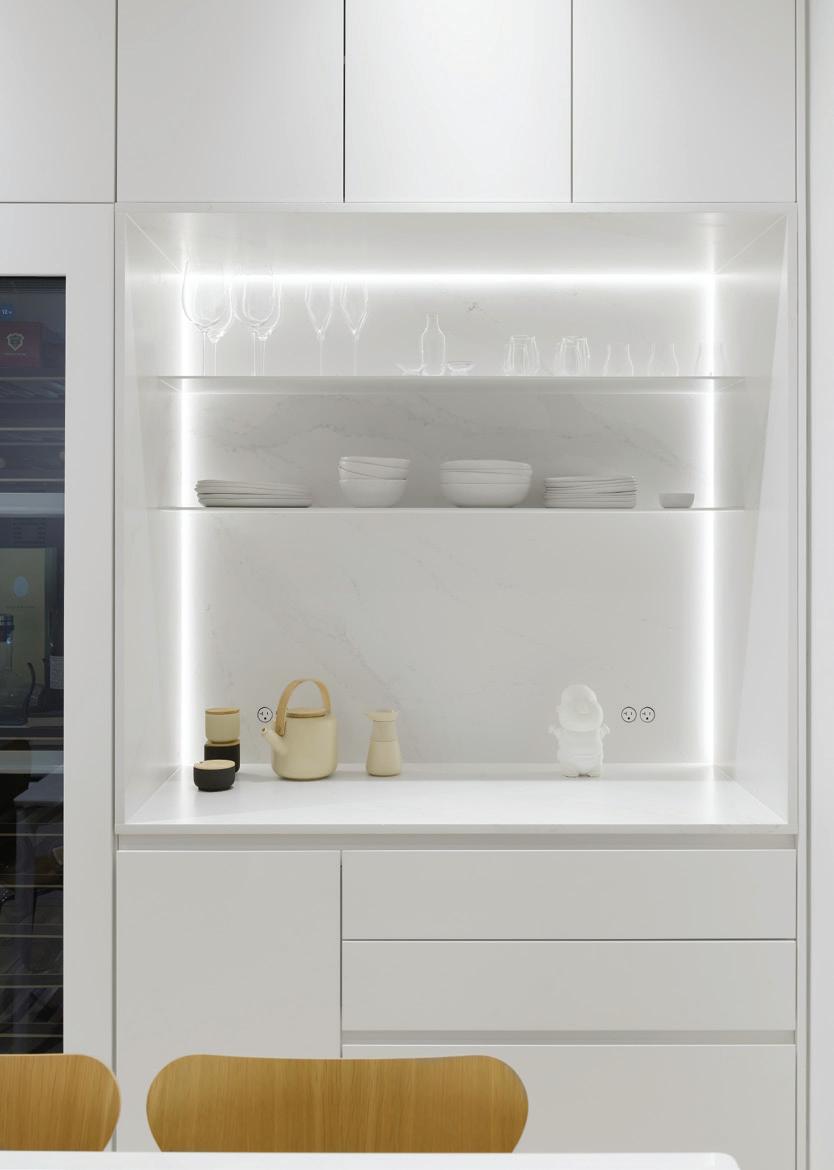

Ultra-compact porcelain stone was used for the counters and fireplace face, bringing a subtle cohesion throughout the home even when tones vary. The simple white-and-black motifs add a touch of masculine drama to this home.

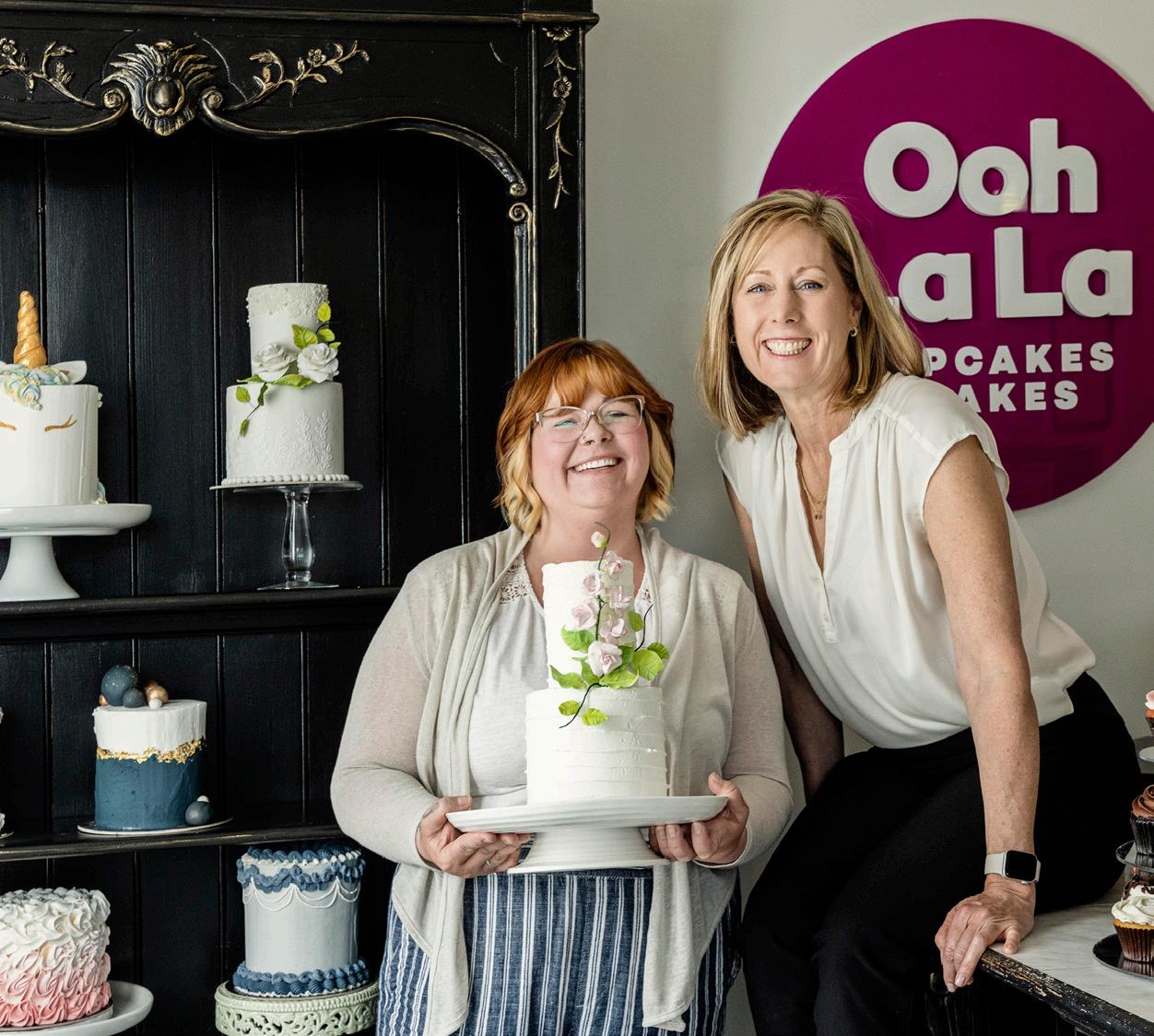
When was the last time you tasted something and said, “Ooh, that’s sooo good”? Consistently referred to as Victoria’s best boutique cupcake and cake bakery, Ooh La La Cupcakes + Cakes is also local and woman-owned and operated. Every piece of edible art they create is made from scratch with quality ingredients and baked in-house to impeccably high standards. For years they’ve been central to so many wonderful celebrations. Their team of bakers, artists and front line happiness consultants are all determined to make your event, celebration, dessert or impulse craving the best it can possibly be. (Check out their Instagram feed and you’ll see the proof!)



Adrift Wood Company captures the art of furniture and the natural beauty within the wood of the Island. The company is proudly owned and operated by a father and son team, working together to bring each piece to life.
Jake Tchida, owner of Adrift Wood Co., envisioned the idea for his company while working as a tree planter in northern B.C. Tree planting is among the hardest work there is, yet it fosters the creation of something new within.
Tree planting was a cornerstone in the foundation of Adrift. Jake’s father, Tim Tchida, began planting trees when was 22 years old, and then in 1988, owned Summit Reforestation, which is now approaching the planting of its billionth tree.
Now a young 60, Tim retired from the planting industry and has partnered with Jake in Adrift Wood Company. His life’s work in the silviculture industry is now a legacy that carries over into the work they do together in the art of furniture building.
Adrift Wood Co. uses new, recycled and
A D R F T
salvaged woods and materials. The salvaged logs are turned on the lathe into elegantly finished stools. Salvaged driftwood is used to create stunning sculptures that capture the natural beauty shaped by the waves and rocks. The solid stone bases for the sculptures are made from recycled granite countertops.
Adrift proudy supports local wood suppliers for many of its fine furniture pieces. Adrift believes that the quality and origin of the materials used reflects the value of the art created.
the wood shop below. Doors are open from 9am to 5pm and 10am to 4pm whenever there are Sunday open house events.
Adrift proudy supports local wood suppliers for many of its fine furniture pieces. Adrift believes that the quality and origin of the materials used reflects the value of the art created.
The studio and shop are embedded in the centre of Esquimalt at #9–744 Fairview Road. Stepping inside the shop, one notices the earthy smell of wood. The studio in the mezzanine is simple and elegant, filled with beautiful pieces made in
The work of Adrift can be found in furniture stores and happy homes scattered throughout Victoria. For now, the company’s focus is local — in Victoria — but they have ambition to branch out. Custom orders are enthusiastically accepted and the team loves to work with clients to create the perfect piece.
Adrift wants to extend a friendly hand to any fellow Island-based businesses to build valuable relationships. If this resonates with you, reach out to us at Adrift Wood Company, and together, we’ll make something wonderful.
#9–744 Fairview Road, Esquimalt | adriftwood.co | 250-877-9539

For over 40 years, MAC Renovations has been a trusted professional in the home renovation space, helping homeowners in Greater Victoria fall in love with their homes all over again through custom renovations and remodels. Whether we’re helping homeowners find room for a new guest bathroom, upgrading a kitchen to the space they’ve always dreamed of, transforming a basement into a fully functioning suite or adding square footage to accommodate a growing family, MAC has consistently delivered excellence throughout the CRD.
This year, MAC Renovations was rebranded as MAC Reno Design Build, highlighting the significant value our crews bring every day: We take care of the planning, design and build elements, providing professional oversight — tempered by decades of experience — for each step of the project. While our name has
changed, our commitment to quality and professionalism remains the same.
Like the renovations and builds we complete every day, the rebranding was completed with purpose. The new logo is eye-catching, memorable and immediately recognizable as pure MAC. The changes to the website have improved readability and user experience while modernizing the overall look, ensuring that people searching for our services find us quickly and easily.
Visit MACreno.com to see the new brand and our gallery of award-winning projects we’ve completed over the years. Watch for our vehicles, crews and projects throughout the community: outstanding examples of the professionalism, talent, creativity and trust we bring to every project we take on and every conversation we have.
Contact us to schedule an in-person meeting in our Design Showroom, where you can see, touch and experience the

“This name change allows us to continue to be known as Greater Victoria’s leader in custom home construction, design, renovation, home care and repair while extending our reputation for excellence through commercial projects that meet — or exceed — MAC’s rigorous standards. Whether you choose MAC Reno Design Build or MI Construction, our aim is to impress you through every encounter.”
—Blaise McDonald, president
MAC Reno Design Build and MI Construction
wide range of design materials we use in our projects, then meet our team of elite construction professionals responsible for the state-of-the-art homes we design, build and renovate throughout Greater Victoria.

Sure, you can make a simple design statement with a splash of colour on just one wall. But should you? We ask the experts.
By Nessa Pullman
In recent years, feature walls have become a hot topic of debate in the design world. Are they still the go-to element for visual interest to a space? Or are they an outdated and unimaginative trend that is well past its expiry? The pendulum has swung both ways and now we are asking once and for all: Are feature walls still in or are they out?
A feature wall, also known as an accent wall, creates a statement, a visual impact that stands out against the rest of the space. This is most often done by applying a contrasting element such as a bold paint colour or an ornate wallpaper to one wall in a room. Typically, the wall chosen to feature is the most obvious choice, such as the fireplace wall in a living room or the headboard wall in a bedroom. Once the furniture is in place, the “feature” comes together effortlessly.
By only having to commit to one wall, homeowners can be a little adventurous — but not too adventurous — which makes the feature wall a popular, low-risk design choice. But ask the trendspotters in the design industry, and they have their own, decided opinions. So that is just what we did, checking in with three of Victoria’s top pros.
Here’s what they have to say.

“Creating a feature is an integral part of design,” says Danielle Keogan, principal designer at Maverick Design. “But the days of slapping on a bold colour or wallpaper are certainly over.”
She explains that people are done with the same-old, same-old colourful single wall and are looking for ways to create experiences with their feature walls, ones that bleed into the entire space. “At their core, features [within design] are ways for people to self-express,” says Keogan, which is why she likes to go for the more unexpected choice when choosing a feature wall. “I like working with the negative space, finding ways to carry a rhythm throughout the home.”
Rather than just relying on a colour change, Keogan prefers to work with texture to create

Government incentives and rebates, reduced electricity bills, and increased property value
Energy efficiency, reliability, and independence
All of the above


Oceanvolt Solar & EV is proud to support BC Hydro’s new $10,000 solar and battery storage rebates and the federal Greener Homes Loan Program where residents can take advantage of up to $40,000 with an interest-free loan and a 10-year payback.
Consider texture instead of colour — it’s a more modern way to create a feature wall.

—Yiely H.
“It’s a gift to find a dental clinic that is as meticulously thorough as it is beautiful. I felt like I was at the spa while also receiving dental care.”



a tactile and multi-dimensional experience, using a variety of natural materials like shiplap, tumbled limestone and slated wood to create an architectural element. “A feature wall is about creating a unique detail that the space didn’t inherently have before.”
They’re in.
For Iván Meade, principal designer at Meade Design Group, his opinion on feature walls hasn’t changed. “They will always be in,” says Meade. “Because they create a focal point, and those are crucial for creating an impression.”

Meade believes that having a strong visual element is vital for creating a memorable space. “We want to create an impact,” he says. “Something people will remember well after they leave.”
Meade’s favourite way to create a feature wall is to work with balance and symmetry, using a variety of levels and shapes placed strategically to create a harmonious architectural element. “There must always be a sense of volume and depth,” he says. “You want to avoid any flat or flush surfaces.”
Feature walls are also a good place to tap into recent trends, like the popularity of marble. “Playing with scale and height using large format materials can have a big visual impact,” says Meade, adding, “Many colour combinations from the ’80s are making a comeback. But a little toned down, so it’s softer and more livable.”


I specialize in helping women establish financial freedom and independence following a loss or major transition. I know firsthand how traumatic the loss of a spouse can be – and that a major concern for most women is their financial situation. My goal is to take away that worry by helping you create a financial plan that allows you to live life to its fullest, support your family, and build wealth for the long-term – without worry or fear.
Are you curious about finding out where you stand in terms of meeting your financial goals? Call or email Shine Financial Group to book your complimentary goals assessment.


Charlotte Paul, CIM, Associate Portfolio Manager 250-590-0603 cpaul@assante.com

“Custom-designed millwork with storage units naturally creates an architectural feature.”
They’re in — sort of.

From the beginning, the purpose of a feature wall has been primarily esthetic — an easy way to spruce up a drab room and add a wow factor. However, Ann Squires Ferguson, CEO of Western Design + Build, is seeing a shift. “I believe that feature walls — as strictly esthetic — are old news,” she says. “Instead, we are moving towards a more functional direction.”
Squires Ferguson explains that a feature wall can fulfil a practical function and still be esthetically appealing. Building a wet bar or vinyl listening station into a feature wall is a way to incorporate functional pieces into a visually stunning element. “These days, we are all trying to do more with less,” she says. “So finding ways to incorporate multi-functional items into our design is ideal.”
The minimalist movement is still going strong and, with people continuing to downsize and live more simply, having multi-functioning design choices is essential. Squires Ferguson says that incorporating storage into feature walls is also very popular right now. “Custom-designed millwork with storage units naturally creates an architectural feature,” she says.
So what does all that mean for your own home? Although slabs of bright paint and garish wallpaper seem to be remnants of a bygone era, it seems that feature walls are sticking around — but with some muchneeded improvements that make them functional, intentional, personal and beautiful.

The modern feature wall should be functional as well as visually arresting. It could, for instance, incorporate custom shelving that combines storage with display space. In a kitchen, colourful cabinetry transforms practical storage into a thing of beauty.

Another interesting way to create a feature wall is with plants — also known as a living wall.
Over the past 15 years, people have been experimenting with different ways to bring plants inside their homes. Eventually, the only place to go was up. “People want to be around nature,” says Jennifer Lasko, owner of ModPots, a small-space container and garden design company in Victoria. “We needed to find a way to make it more accessible.”
There are a variety of ways to create these living walls, including planters, hanging baskets and moss art. One easy way is to use a product Lasko carries called WallyGrow, a removable planter that has an integrated water reservoir for easy maintenance. These can be hung on the wall in any pattern or shape and can grow a variety of different plants, including herbs and food, creating a versatile garden for those in small spaces.
Living walls aren’t just beautiful and visually intriguing — there is a long list of benefits nature has on our overall physical and mental well-being. “The Japanese have this term called shinrin-yoku,” says Lasko. “It’s a practice of therapeutic time spent with nature.” (It’s also sometimes called “forest bathing.”)
So if you’re looking to create a feature wall, integrating living, breathing plants into your space could be the best choice of all.



WEDNESDAY SEP 18 7:00 PM


Internationally celebrated singer, composer and best-selling author. A member of the Order of Canada, Polaris Music Prize and JUNO Award winner. “One of the avant-garde’s most dynamic performers.” Rolling Stone tanyatagaq.com with the Victoria Symphony and Emily Carr String Quartet OCT 10 - 12 7:00 PM OCT 12 2:00 PM at the Metro Studio


Follow the YAM guide to getting dinner on the table — even when you’re too busy to cook.
By YAM Staff
Illustrations by Janice Hildybrant
It’s 6 o’clock on a Tuesday night and everyone’s getting hangry. But the pantry is empty and so is your imagination. Right. Skip the Dishes it is — again.
With our busy lives, making dinner isn’t always easy, especially mid-week, but it’s important.
Gathering around the table is our chance to connect with each other, to check in on everyone’s well-being, to share the highs and lows of our days. Putting a home-cooked meal on that table brings everyone together — and it also means your family is eating food that is nutritious, delicious and lower in the salt, sugar and fats that make restaurant food so tasty and not always so good for us. And it’s almost certainly less expensive than delivery, whether you’re ordering pizza (what, again?) or a meal prep service.
But planning, shopping for and cooking those nutritious meals can be hard, especially in September, when we’re so busy
with work and school and all our many other activities.
That’s why we’re here to help. What follows is the YAM guide to fixing the weekday supper.
This isn’t a meal planner. You can find many of those online, but we often feel that they are either way too complicated, or they don’t fit our lifestyles, or the foods they suggest aren’t really the ones we like to eat. Instead, this is a strategy that you can adapt to your own life, what you like to cook and what you and your family like to eat.
Just follow the three Ps: plan, pantry and prep.
Before you even start your grocery list, stop a minute and think about how your week actually unfolds. Is there a night everyone is out? A night when you know you’ll be too tired to cook? When your fridge starts to run empty? Are there dietary or cultural needs to accommodate? Will you have guests to feed?
Mondays can be the toughest
day of the work week, which means this is generally not the night to try a complicated new recipe. A simple pasta dish and tossed salad would be ideal — nourishing, comforting and on the table in half an hour or less.
Friday, on the other hand, might mean friends popping over for wine and tapas. You might want to stock up on fancyish pantry nibbles (crackers, olives, tinned fish, salami, hard cheese), or plan for a second shop later in the week.
Take a little time before you do your weekly grocery run to plan what you’re going to cook. Include dishes that you can cook from pantry items or prep ahead of time. For instance, if you cook a pot of beans on the weekend, during the week you can add a handful of them to a minestrone soup, stir some more into a grain bowl and mix the rest into a pot of chili. (See page 59 for more ideas.)
Gather your recipes and jot down all the ingredients you need.
Check to see if any of them are already in your pantry. While you’re at it, note any staples that might be running low (see sidebar on page 60 for what you should stock in your pantry).
Once you know what you need, reorganize your list by (a) where you’ll be shopping, if there’s more than one stop, and (b) the department where you’ll find the item (for instance, dairy, meat, produce, dry goods). Then off you go, and don’t forget your reusable bags!
Your pantry is the key to making dinner easy and a pleasure to prepare. While it would be lovely to have a gorgeous walk-in room where everything is decanted into glass jars with beautiful blackboard paint labels, that is rarely a reality. What you need is an accessible space stocked with things you actually use. Remember: That space includes your kitchen cupboards, your fridge and your freezer.
Continued on page 60
These ingredients are the heroes of the kitchen — if you have them on hand, dinner is just a few minutes away.
Roast a chicken on the weekend or pick up a rotisserie chicken at the supermarket to get a jump on the week.
Use it in:
● Salads (caesar, Thai or classic chicken salad)
● Sandwiches
● Burritos, tacos quesadillas
● Risotto or pasta
● Curry
● Pot pie
● Soup (make stock from the bones, or just add the meat to store-bought broth)
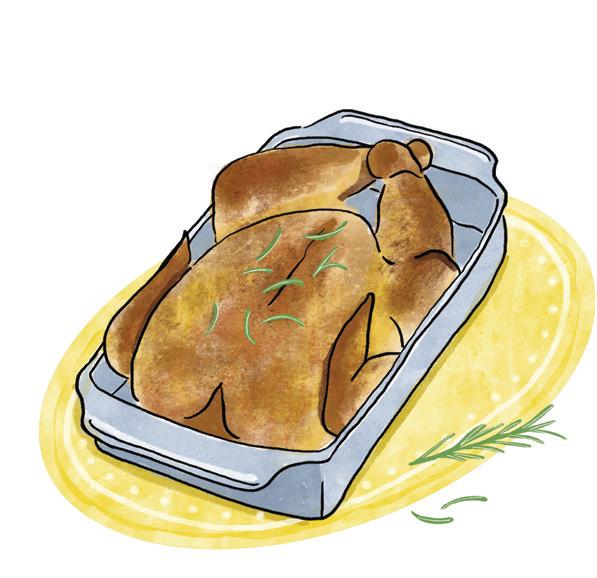
Canned tomatoes are a kitchen workhorse and come in a wide range of formats: crushed, diced, whole or as sauce, passata or paste. We especially love the squeezable tubes of “doppio” (double-strength) tomato paste that are both space-saving and intensely tomato-y.
Use them in:
● Pasta (bolognese, marinara)
● Salsa
● Pizza
● Chili
● Soups
● Stews
● Curries
● Shakshuka
Make a batch of vinaigrette on the weekend and store it in the fridge to use all week. (See recipe below.)
Use it in:
● Salads (green, grain, potato)
● Roasted veggies
● Bean dishes
● Marinade for grilled meats

Use this simple vinaigrette in salads, marinades and so much more.
• 1 cup olive oil, preferably good quality extra-virgin
• cup white wine vinegar
• 1 to 2 tsp Dijon mustard
• ½ tsp salt (or to taste)
• Few grinds of black pepper



Stock up on canned beans or prep a pot of dried beans (black, navy, kidney or cannellini), lentils or chickpeas in advance.
Use them in:
● Soup
● Chili
● Salads
● Grain bowls
● Huevos rancheros
● Countless side dishes
Protein-rich eggs are endlessly versatile, essential in many dishes and the perfect extra to many others. Remember: Almost everything is better with a jammy egg on it.
Use them in:
● Salads
● Soups
● Quiche
● Custard
● Sandwiches
● Omelettes
● Frittata
Combine all the ingredients in a sealable 500 mL glass jar and shake well. Store in the fridge and shake again before using — you’ll only need a few tablespoons at a time to dress a salad. Makes about 1 ½ cups.
● Ramen
● French toast
● Shakshuka
● Huevos rancheros
● On their own, boiled, poached, fried, scrambled or devilled

You can always add some exotic spices or fancy condiments, but the priority should be the stuff you reach for again and again. This will vary depending on what you cook. If you make, say, a lot of Thai food, you might consider fish sauce, rice stick vermicelli and curry paste essential. On the other hand, if you’re into Italian cuisine, you’ll want to stock up on dried pasta, crushed tomatoes, olive oil and Parmesan. And if you’re a baker, well, that’s a whole pantry unto itself.
Keep the things you use most often where they are easiest to reach. And make them easy to see — keep labels facing outward and avoid any
storage solution that hides the contents. Wicker baskets are pretty, but if you can’t see what’s stored in them, you’re unlikely to use it.
Also consider decanting grains, cereals, legumes, noodles and the like into clear plastic or glass containers that vermin can’t chew through. One handy tip: Label each container with the cooking instructions as well as the contents.
Finally, one smart way to get a jump on the week is to prep some of your weekday meals over the previous weekend. You could make a pot of turkey chili, chicken soup or beef stew. Or you could
whip up a baked lasagna or enchilada casserole. Then all you need to do is reheat it when you get home from work.
But who wants to spend all weekend cooking? Instead, while you’re already in the kitchen, prep one or two components of the next week’s meals so you can assemble dinner in a snap come Tuesday or Wednesday.
For instance, if you’re making a roast chicken for Sunday dinner, you could add a second one to the roasting pan and use it all week long in sandwiches, risotto, pasta and salad. Or, if you’re grilling ribeye, add an extra steak to the BBQ and use it on Monday in a main-course salad.
Other easy prep: Cook a pot of beans or whole grains for salads, soups and nourishing bowls. Make a jar of vinaigrette for easy salads. Chop some veggies and store them in an airtight container, ready to roast or stir-fry. (For the best taste and texture, choose cruciferous vegetables like broccoli, cauliflower or kale or non-starchy root veg like beets, carrots and radishes. Avoid delicate lettuces, fresh herbs and starchy root vegetables like potatoes, parsnips and turnips.)
And use our handy guide on page 59 for more ideas and inspiration. With a wellstocked pantry, a smart plan and just a little bit of prep, future you will thank you.
What you keep in your pantry depends on what you and your family like to eat. But the following essentials can make cooking easier for everyone. Remember that your pantry isn’t just one space, but comprises your fridge, freezer and cupboards, too.
Chicken (or vegetable) broth: For sauces, soups, stews, risotto, paella and countless other dishes. Canned or in tetra packs. If space is an issue, Better Than Bouillon is a high-quality dehydrated broth that comes in a jar and can be mixed up as needed.
Noodles: If you have noodles, you can make a satisfying meal in minutes. Depending on what your family eats, stock up on Italian-style pasta, German butter noodles, Vietnamese or Thai rice noodles, Japanese ramen or whatever you prefer.
Rice: Another handy starch that makes a quick and easy side dish or main. Think short-grain rice like arborio for risotto or paella, and long-grain rice such as basmati as a side dish, especially for curries and other Asian dishes.
Parmesan cheese: Essential for pasta and risotto, great on salad or in soup, and will last almost forever.
Dairy: Milk, butter, cheese, yogurt and, above all, eggs. There are endless things to do with protein-rich eggs, one of the world’s most perfect foods, plus you can add a fried or jammy boiled egg to just about everything from pasta to sandwiches to salad to soup.
Beans, chickpeas, lentils: Canned or dried. Dried is more economical, but canned is quicker. Legumes are versatile, hearty and packed with fibre, protein and other nutrients. If you’re eating a lot of veg-forward meals, they are an easy way to add protein.
Canned tomatoes: For pasta sauces, chili, soups and stews. Crushed tomatoes are versatile and easy to use, but whole or
diced tomatoes, tomato sauce, “passata” and “doppio” (doublestrength) tomato paste are also handy options.
Oil and vinegar: Vegetable oil for cooking, extra-virgin olive oil for salads, plus white- or red-wine vinegar are the basics.
Aromatics: Onions, shallots and/or garlic are essential for many dishes, so it’s wise to have some in the pantry. Keep them in a cool, dark, dry place, away from other produce or anything that can absorb their pungent aromas. (Cut onions, as well as fresh alliums like scallions, leeks or chives should be well-wrapped and kept in the fridge). Aromatics can also include: lemons, ginger root, celery, peppers (both hot and mild), fennel, carrots and fresh herbs.
Frozen foods: Ground beef or turkey, chicken thighs or breasts, nuts (walnuts, almonds, pecans), veggies (spinach, peas, corn). If you have time and space, add pre-prepped items like cooked beans, pasta sauces, stews, soups and chili.
Spices and condiments: Salt and pepper are essential — we like Diamond Crystal kosher salt for cooking and flaky sea salt for finishing dishes, as well as whole black peppercorns to be ground fresh. Also consider: crushed red pepper flakes, Dijon or grainy mustard, mayonnaise, salsa, soy sauce, hot sauce (sriracha, Valentina, Tabasco, etc.) and whatever spices and dried herbs you need for the dishes you like best.
Staples and snacks: Flour, sugar and other sweeteners, coffee, tea, baking supplies, nut butters, tinned fish (tuna, salmon), breakfast cereals, granola bars and the like.





Sat, Sept. 21: empower
Sat, Sept. 21: Eat, drink & empower

Join eight of Victoria’s top chefs and 250 community and business leaders for a heartfelt culinary competition and Our Place gala fundraiser.
Join eight of Victoria’s top chefs and 250 community and business leaders for a heartfelt culinary competition and Our Place gala fundraiser.
All funds raised will support Our Place opening the first long-term addiction recovery community for women on Vancouver Island.
All funds raised will support Our Place opening the first long-term addiction recovery community for women on Vancouver Island.
Tickets are limited! Reserve yours today at:
Tickets are limited! Reserve yours today at:
ourplacesociety.com/hungryhearts
ourplacesociety.com/hungryhearts








PROUDLY SPONSORED BY
PROUDLY SPONSORED BY















Breathing is the basis of meditation, yoga, tai chi and, well, life. Get it right, and it can improve every experience you have. Here’s how to do it.
By Alex Van Tol
You take 20,000 breaths a day. The tough news is, you’re probably doing them wrong.
Check yourself right now: Where are you breathing? Up in your chest? Or was your belly loose and soft just then, open to literal inspiration?
If you’re like most people, your stomach muscles stay locked throughout the day. This is called shallow breathing, and it signals a state of stress to our brains and bodies. “When our belly is pulled tight, that’s part of the fight-or-flight response,” says Michele Yasuda, director of programs for the Hendricks Institute in California, which trains therapists and coaches in somatic processes. Yasuda has studied breathing for the better part of a decade alongside Dr. Gay Hendricks, pioneering psychotherapist and author of Conscious Breathing: Breathwork for Health, Stress Release, and Personal Mastery, who began his lifelong affair with the breath by studying both traumatized and contented newborns to discern how to unravel life-disrupting breathing patterns in his clients. Learning how to breathe with easy, connected breaths can change your mood, improve your circulation and your orgasms, reduce pain and stabilize your emotions. Only trouble is, because of the hurry and stress we carry, our nearconstant state of overwhelm locks us into shallow, fight-or-flight breathing most of the time — whether there’s tangible danger or not.
that tension. Drawing a “belly breath” activates the diaphragm, a thin muscle that sits below your lungs and spreads across your chest cavity like a parachute. This little parachute relaxes as you exhale, “billowing” skyward, and contracts on the inhale as it pulls downward to draw the breath in.
Activating your diaphragm sends breath into the lower third of your lungs, where the majority of their vasculature resides. This feeds more oxygen into your bloodstream. If you’ve ever had a few hits of pure oxygen, you’ve felt its power.
“It calms the nervous system to be breathing into a soft belly,” says Yasuda. “I’m letting my whole system know I’m safe. I’m OK in this moment. I’m not in danger right here and right now.”
If you can voluntarily loosen the muscles where your belt typically goes, do so. Close your eyes to let yourself focus. Now imagine drawing breath into your belly button. (Of course you can’t breathe through your belly button — but if you can imagine feeling like your body is doing so, you’re all set.)
You don’t have to exaggerate or be big about it. “In the Taoist tradition,” says acupuncturist, tai chi teacher and Lumina Wellbeing owner Lin Chen, “[the breath] needs to be deep and quiet, thin and long. It’s so subtle that we’re not feeling much.”
Activating your diaphragm sends breath into the lower third of your lungs, where the majority of their vasculature resides.
Breathing practice doesn’t need to take much time; after all, you’re already doing it. “The best time for practice is early in the morning, like 4 to 6 a.m.,” says acupuncturist and tai chi teacher Lin Chen, of Lumina Wellbeing. “Sunrise and the hour before sunrise, according to the yogic tradition.”
When we’re in a relaxed state, our bodies soften and our breath deepens. You might notice you breathe with slow, deep belly breaths — what Hendricks calls “happy baby breathing” — when you’re drifting off to sleep or just waking up, before your head gets a hold of the day. “When we’re in an aware space, we will actually do a natural, diaphragmatic breath,” says Katyanna Ryan, an acupuncturist, yogi and cofounder of MĀ Wellness and Yoga in Dragon Alley. “But what happens is we get really up into our minds and we start spinning, and then we start to notice the body will tighten.”
Proper breathing can counteract all

When you wake, try not to busy yourself right away, but instead take five minutes to focus on your breathing. The key is consistently offering your body this small practice every day. And tune in throughout your day, in those moments when you become aware that you’re aware. Just check in and see where you’re breathing.
With continued discipline, you’ll begin noticing overall improvements in your life. There isn’t a realm of your existence — emotional, spiritual, sexual, intellectual or physical — that won’t be improved by easy, connected breathing.
“It’s everything,” says Chen. “It regulates our mood, calms our mind. It brings more clarity. Breath is life force. Be able to breathe properly so the life force can circulate properly.”
Breathwork comes in many forms, but today our work isn’t about achieving near-psychedelic states of consciousness like you can in holotropic breathwork (think Dutch motivational speaker and extreme athlete Wim Hof). When it comes to everyday breathing, we’re looking for easy, continuous breaths.
While you’re at it, keep the inbreath and out-breath circulating through your nose. If your purpose is to let go or cleanse, then exhaling through your mouth is appropriate. “But if we are trying to invite the energy in the body to circulate properly,” says Chen, “we should breathe in and out of the nose.”
If you can’t yet loosen your belly muscles, this is just fine. You’ve grown up in a world that values being in a hurry — and literally holding it in. A surprising number of people can’t relax their stomachs. Try lying on the floor to take the pressure off your muscles. That’ll help you focus on your abs.
Watch your stomach. See if you can invite it to rise with a full soft breath. If you can’t, put a book on your tummy. Keep watching. Keep inviting the breath in through your belly button. “Once you get that feeling,” Chen says, “then it’s easier to do it seated or walking or in just everyday life.”
1. Being here now.
Proper breathing returns you to the present. “Breath is used throughout the ages in yogic practices in order to ground your awareness,” says Ryan. “It brings awareness to what’s happening now so we can properly respond, whether that be on a physical level or a mental/emotional level. With that awareness, we can relax certain muscle groups that we tend to hold when we are in a state of fight or flight.”
2. Discerning body signals and emotions.
Breathing softly tunes you into what’s happening in your emotional world — which is what runs the show, for better or worse. “When we’re not breathing properly, we’re cutting off our body intelligence,” says Yasuda. “We’re all familiar with butterflies in the stomach as a concept of fear, but that’s only one of the ways that our body communicates through our sensations.”


3. Calming your nervous system.
In the Taoist tradition, correcting anxiety is as easy as bringing awareness into your feet and “breathing out” through your soles, says Chen. You’re literally sending your energy down, physically and metaphorically. (Bonus points if you can get outside and put your feet on the actual ground; the energy exchange is very healing.)
4. Unhooking from pain and tension.



Ryan regularly works with injury, which is often directly connected to the way a person breathes. She sees a lot of people who hold tension in their abdomen, sphincter or pelvic floor. “Some people have actually, just from exercise alone, created a body that doesn’t breathe properly because they can’t soften their abdomen,” she says. “Many people are surprised that their injury is caused by the way they’re breathing.”
5. Interrupting anxiety or rumination.
You can get a handle on a thought spiral if you divert attention to your breath. “If I’m consciously breathing, I’m using some of my attention for my inner world,” says Yasuda. “I’ve interrupted that habitual thought even just a little bit by putting some of my attention on my breathing.”
65 IN SEASON Apples to Love, Hot Eats in Esquimalt, Crust’s Cookbook and More
68
DINING IN Pasta, Perfected
74

72 Green Ricotta Ravioli
73 Kara’s Perfect Pasta Dough
It’s easy to take the apple for granted. It’s the one-a-day fruit after all, available year-round, sweet and crunchy and good for you, but a bit boring, right? Not when it’s a local apple. B.C. grows some of the best apples on the planet, in varieties that include Ambrosia, Honeycrisp, Pink Lady and Salish. There are new cultivars being developed by Summerland’s Okanagan Specialty Fruits, like the nonbrowning Arctic series, and heritage ones like the Duchess of Oldenburg, which dates back to 18th-century Russia. It’s just one of the 450 different types of apples grown at Salt Spring Apple Co., which also sells cider, apple treats and organic trees you can plant yourself. Apples are ripening now through October; pick up a bag or a bushel and make apple butter, pie, muffins or cake, pair them with pork chops, add them to soups, salads or curries, or just eat them out of hand, no effort needed. Now that’s something we’ll never take for granted.


Chef Andrea Aldridge brings hot skills and live-fire cooking to restored Rosemead House.
By Joanne Sasvari
Andrea Aldridge is ready to light a fire under the Victoria dining scene. The talented chef is bringing her passion for live-fire cooking to Janevca Kitchen and Lounge, the gorgeous new restaurant at Esquimalt’s lovingly renovated, circa 1906 Rosemead House.

“The whole concept is local ingredients, wood-fire driven,” she says. “With the fire, we’re going to have a bit of a steak program. We’ll have dry-aged steaks and whole-animal butchery. We’ll be doing wood-fired smoking as well.”
The 2021 Top Chef Canada finalist is inspired by Francis Mallmann, the Patagonian chef known as the king of outdoor cooking, but brings with her nearly a decade of experience in some of Vancouver’s best Italian restaurants — CinCin Ristorante and Osteria Savio Volpe — and plans to introduce a “really extensive” pasta program. But she also intends to explore the cuisine of her own Jamaican-Filipino heritage. “Now it’s time to show what else I can do,” she says.
The restaurant, named for owner Lenny Moy’s three children, Janelle, Evan and Cailee, is scheduled to open by September and features 96 seats, a year-round patio, a cozy bar and lounge, and two private dining rooms. But for Aldridge, it’s all about the luxe Grillworks wood-fired oven. So what is it she loves so much about cooking with fire?
“The smell. The feel, the attention to detail it demands from me. The flavour you get out of, not just meat, but vegetables, you just can’t compare,” she says. “It’s all of it.”
It’s the season’s must-have baking book.
By Joanne Sasvari
Tom Moore is flipping through his new cookbook, Crust: Essential Sweets and Savories from Victoria’s Beloved Bakery, past photos of cookies and scones and snacking cakes, the chocolatey Rice Krispie squares he made for his daughter Abby, the “bulletproof” garlic-androsemary focaccia that everyone loves, the flourless orange almond syrup cake he developed with his mother back in Australia, the brownies for his wife Pennye. And at almost every page he pauses and says, “Oh, that looks good.”
It sure does.
Crust, of course, is the legendary bakery on Fort Street that Moore owned and operated with his ex-wife Crystal for nearly a decade, until he sold his share in 2022. (He’s since opened Tombo Eats, a casual daytime café/bakery/ lunch restaurant just two blocks from his former digs.)
“It was an incredible business, but it was time for a change for me,” he says. The book, he adds, “is the memory of Tom at Crust. It’s bittersweet.”
He’d long wanted to write a cookbook, but the timing was never quite right, not until three years ago, after they’d opened the Crust kiosk at Uptown and cookbook author Rebecca Wellman (First, We Brunch) suggested they join forces.
“That’s when I thought, right, everything is in the right place,” he says. “You’ve got to have time, you’ve got to have money, you’ve got to have a brand. It’s all got to come together.”
They sent a proposal along with a package of baked goods to Appetite by Random House, then once they got the goahead, brought photographer Peter Bagi on board.
The book became something of a community project. “My


neighbours helped, my mom helped in Australia, my wife’s friends, everyone,” he says, noting that each recipe was tested — and taste-tested — multiple times. “There’s a little piece of me in all of these.”
Even the biggest problem they faced — converting the grams that professional bakers use to the cups and teaspoons preferred by home cooks — became a community-building moment. He turned to Anna Olson, Canada’s queen of baking books, who shared her
own conversion table with him. “We got it all into line, but boy oh boy,” Moore says with a laugh.
The result is a book that is as useful as it is beautiful, filled with crave-worthy recipes that even a novice baker can actually make.
“The whole idea is to be able to create something from anybody’s home,” Moore says. “It might not be perfect the first time, but the next time it might be, and it will still be delicious.”

By Cinda Chavich
Foraging is a hot topic among chefs, but how about digging around in the backyard for something new and interesting to eat?
Mikaela Cannon is an organic farmer and forager based in the North Okanagan and says she can feed her family of four with food she produces and forages herself, including the edible “weeds,” plants and trees in her own backyard.
During a walk through one of Victoria’s public food forests — Spring Ridge Commons in Fernwood, one of several across the city where anyone is welcome to forage for food — Cannon pointed to a variety of tasty plants, ranging from miner’s lettuce and nettles to burdock, sorrel, rosehips and edible conifers. You can also create a year-round permaculture space at home just by planting some native plants, whether the aforementioned miner’s lettuce and nettles or things like elderberry, oxeye daisies and Oregon grape. You can also designate a corner for “weeds” such as chickweed, lamb’s quarters and dandelions, all healthy greens for the salad bowl.
Cannon blogs (at forestfables.ca) and offers workshops focused on responsible foraging and wildcrafting from her farm near Armstrong. Her new book, Foraging as a Way of Life (New Society Publishers), is a guide that will inspire you to gather dinner while doing your weeding.
• Are you all fired up about Brewery & The Beast? This annual food festival goes September 22 in Victoria with music, craft beer and lots of meaty dishes, all prepared over live fires for a three-hour outdoor feast. breweryandthebeast.com
• This fall, the U.S.-based Korean grocery chain H-Mart is taking over the former Toys ‘R Us space in the Mayfair Shopping Centre with a 2,800-square-metre Asian food store. It’s the latest in a chain that comprises 115 outlets across the continent. hmart.ca
• Day to Day Grocery, a large new market on Burnside Road, offers a wide array of South Asian groceries and produce, including fresh curry leaves, okra, whole wheat roti, spices, lentils and tasty frozen Indian meals from B.C. food producers. daytoday.ca


The right fuel can transform a meeting into a brainstorming session and a simple lunch into a catalyst for innovation.
Alibi Catering offers catered office breakfasts and lunches. Promote sustained energy and creativity with our vibrant salads and other delicious, protein-packed delights.
Inspired by Italy’s grandmothers, a new generation of chefs has discovered the joys of making pasta from scratch. Now it’s your turn.
End dive is a cool, buzzy restaurant with an open kitchen and cocktail bar. But there’s another side to this locavore haunt. Or shall I say, another layer?
For while the chefs and bartenders are busy putting on the show upstairs, down below in the basement, Kara Martyn and Lisa Maas are doing something delightful — they’re artfully crafting an amazing array of handmade, artisan pastas.
Like so many chefs these days, Martyn and Maas have taken a deep dive into the world of fresh pasta, following Italian Instagram nonnas (@pastagrannies) and celebrity chefs, and learning all about crafting the traditional shapes you might expect to see in Rome or Bologna.
Their underground pasta-and-bread kitchen is dominated by a massive wooden baking table where every day the pair makes three fresh pasta choices for the restaurant, “a strand pasta, a shaped pasta and a stuffed pasta,” Martyn says, each paired with seasonal sauces created by chef Mat Clarke.
What’s really impressive, though, are the duo’s unhurried and exacting skills — rolling, cutting, filling and forming each individual piece of pasta, like perfect little pieces of edible origami.
They’re very, very good at it — and with a little practice, you can be, too.
For generations, Italy’s grandmothers — the nonnas — have crafted regional pasta shapes from basic ingredients (flour, water, maybe some eggs), using just a few simple tools. Now they are inspiring a new generation of chefs and home cooks alike, and becoming rock stars among the culinary world’s handmade pasta aficionados.
Among the first to tap into this skill set was Jamie Oliver. In his 2018 cookbook, Jamie Oliver Cooks Italy, the British celebrity chef introduces us to these skilled women cooks, from “the
By Cinda Chavich

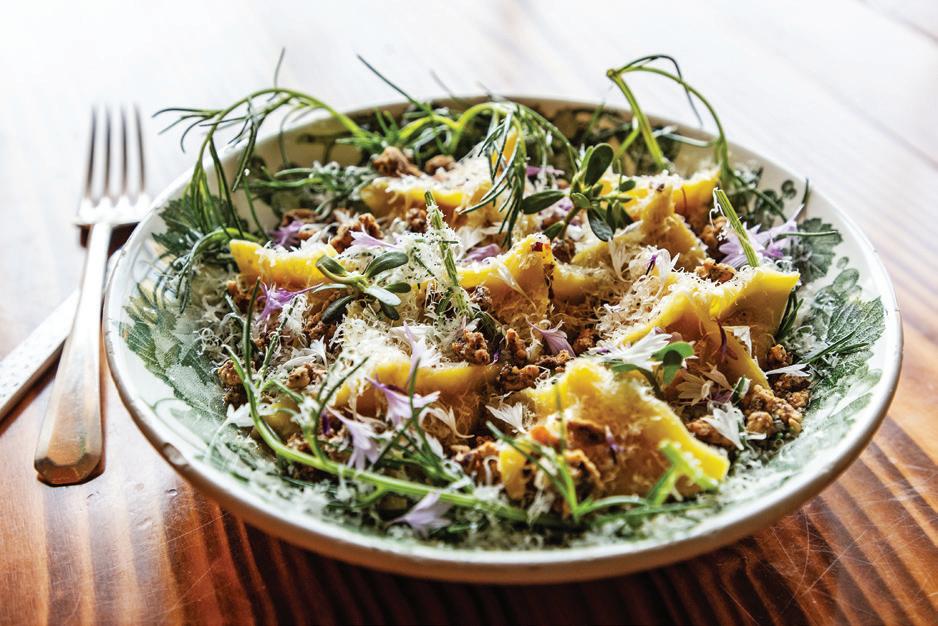
At end dive, from-scratch cestini are filled with a purée of housemade ricotta, horn peppers and fermented habaneros, then served on a bed of salsa di noci, the slightly briny bitter green known as agretti, chili crisp oil and hazelnut praline, and topped with corn flowers and shaved Farmhouse Cheese “Heidi.”
orecchiette nonnas” who make fresh pasta every day in the Itria Valley of Puglia to those making cavatelli, ravioli, gnocchi and agnolotti from scratch in cities and towns across Italy.
Of the new pasta evangelists, the renowned Los Angeles chef Evan Funke (Felix, Funke, Mother Wolf) is perhaps the best-known and most influential. He has spent years travelling and studying in Italy, sussing out these grandmotherly knowledge keepers and sharing their skills in his James Beard Award-winning book American Sfoglino and documentary TV show The Shape of Pasta.
On his quest, Funke works alongside these women, perfecting the Old World techniques of kneading, rolling, filling and shaping artisan pasta.
Funke claims that hand-rolled pasta is superior to that rolled in a hand-cranked pasta machine (another Italian invention). Where the manual machine, with its multiple settings, easily creates an elongated piece of thin, even pasta, perfect for cutting into ribbons or squares for filling, hand-rolling pasta preserves tiny air bubbles in the dough, making it especially light.
He’s inspired chefs like The Courtney Room’s Brian Tesolin, who has set up a corner of his small kitchen for rolling pasta by hand, using a massive 44-inch pin called a mattarello. It was created by woodworker and chef Daniel Ewart in his Mission-based Nonna’s Wood Shop. A former sous chef at Vancouver’s famed Italian restaurant Osteria Savio Volpe, Ewart has expanded his woodworking hobby and COVID project into a business supplying handmade pasta-making tools to the growing cadre of professional and amateur cooks who are diving deep into the world of traditional pasta.
Tesolin uses his big mahogany pin to roll a slab of pasta dough into a thin oval sheet with the same strong, rhythmic motion Funke demonstrates in his YouTube tutorials. He quickly creates a large round, rolling it back onto the mattarello to further stretch it paper thin, then makes a square-ish spaghetti by pressing the pasta over a chitarra, a box that’s tightly strung with metal strings like a guitar. His tool kit also includes a variety of wooden dowels, metal skewers and bronze cutters, designed to roll, press and cut his favourite shapes.
Tonight it’s a giant rotolo, a spiral of pasta rolled around a ricotta-and-green-pea filling. Tomorrow it might be tiny tortellini stuffed with squash, ravioli plump with crabmeat or caramelle filled with lemony ricotta and bathed in sage butter.
Making pasta dough is a pretty simple proposition — just a few ingredients combined and kneaded into a stretchy mass that can be rolled thin and shaped. It might be silky,


The maison famille is growing ... maison + tableware is coming soon!








smooth and yellow from fresh eggs, or a rustic flour-and-water dough flecked with whole wheat for chewy little orecchiette or extruded shapes. You can also colour the dough with the bright pink of cooked beets, golden hue of saffron or verdant green of spinach and fresh herbs.
Just remember: With so few ingredients, it’s essential to start with the best quality flour (usually fine-ground “00” although all-purpose will work, too) and fresh eggs.
All the mixing can be done in a food processor or stand mixer. But traditionally, the flour is piled on a work surface and a deep well is pressed into the centre, where you’ll corral the eggs. Then you’ll slowly bring in the flour from the edges with your fingers (or a fork), until you have a crumbly mass that can be kneaded into a smooth ball. Wrap it and rest it for at least half an hour to let the gluten relax, and you’re ready to roll.
Some pasta makers add salt and a splash of water to their egg dough, even a little olive oil. Some use only egg yolks, while others whole eggs. Some stick to the Italian 00 flour, while others mix 00, all-purpose, semolina and even freshly ground whole-grain wheat flour. It’s fine to experiment.
There are more than 300 different shapes of pasta to master — long, short, shaped, stuffed — and only lots of practice makes perfect when you’re committed to learning the old ways perfected by generations of Italian grandmothers.
For pasta-making tools that are as beautiful as they are functional, look to Nonna’s Wood Shop in Mission. Owner (and former chef) Dan Ewart makes hand-turned maple, walnut and cherry mattarellos, brass cutters, intricate ravioli moulds (see below) and custommade corzetti to stamp your pasta with a signature design, all available online. nonnaswoodshop.com
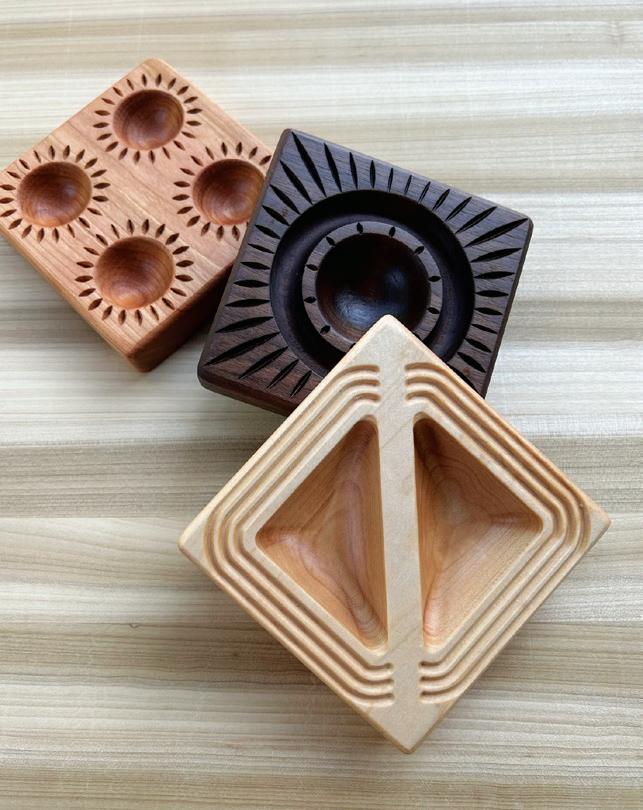
And though there are myriad classic sauces, from meaty ragus to herbaceous pesto, the pasta itself is the star. Try simply drizzling boiled fresh pasta with brown butter or olive oil, and a bit of pepper or Parmesan.
Back at end dive, Martyn uses Anita’s Organic Mill 00 flour with whole eggs for her basic egg dough recipe and, when she needs a firmer dough for making orecchiette or extruded pasta, freshly milled Nootka Rose wheat flour from Metchosin, along with water and a splash of olive oil.
Fillings for ravioli, tortelli and tortellini start with ricotta and/or puréed vegetables,
If you plan to make pasta from scratch, you will need just a few quality ingredients: flour, eggs, salt, maybe some water or olive oil. While all-purpose flour will work, the pros prefer to use finely milled “00” flour. For a Canadiangrown, milled-in-B.C. version, try Anita’s Organic Mill. anitasorganic.com
You will also need a handful of tools. Unless you are using a hand-cranked pasta maker, a rolling pin called a mattarello and a sharp brass cutting wheel are essential, while dowels or brass rods (ferretto), a ridged board (for rolling garganelli or cavatelli) and piping bags for fillings are also handy.
However, if you want to serve pasta for dinner but don’t have the time or inclination to make your own, here are a few locally produced products:
• Try the dried handmade pasta, made with freshly milled organic durum, from chef Massimo Buggini at Triestina Pasta & Provisions. Options range from handcut herb pappardelle to bronze-dieextruded shapes, sold in their kitchen shop in Saanichton or at local farmer’s markets. lapastatriestina.com
• Cowichan Pasta Company also makes dried pasta from stone-ground B.C. grains, as well as frozen ravioli stuffed with fillings such as smoked cheese, venison and chanterelle or Dungeness crab and squash. Find them at select local markets. cowichanpasta.com
• At La Pasta La Pizza in the Victoria Public Market, find classic frozen or dried pasta and sauces, including lasagna, spaghetti with meatballs, seafood fettuccine and butternut squash gnocchi, all available to go. lapastalapizza.com
she says. A simple one would be ricotta and lemon zest for tortelli, though today Maas is piping a deep green purée of cheese with wild nettles.
“We don’t really have a ‘recipe,’ but usually sauté onions, garlic and food process it with anything (ricotta, sweet potato, squash) as long as the filling is a good consistency and not too wet,” she says, “and then you can just season it to taste.”
While Martyn attaches her Torchio B to the table (an Italian-made contraption for extruding fresh spaghetti and other shapes through bronze dies), Maas is busy cranking a piece of golden egg-based dough through a rolling machine until it’s thin enough to see
the woodgrain of her work table.
She quickly glides an expandable, fiveheaded stainless steel pastry cutter along its length to cut perfect strips, then perfect squares. Each is then quickly rolled around a wooden dowel and over a ridged paddle to create tiny, hollow garganelli. She repeats the process dozens of times.
It’s the same with the squares. She dabs each with a nettle mixture, folds a corner over the filling, then pinches the pasta shut to form perfect little pockets of tortelli with “bat wings.”
The work is an exercise in smooth, elegant repetition, a dance that’s both precise and meditative. They never tire of it — and neither do we.

1 Dungeness crab
1 lb mussels
1 lb clams
4 Spot prawns
1 tin Finest at Sea crab boil spice
¼ lb butter
1 lemon, cut into wedges
¼ cup sea salt
2 cloves garlic
¼ lb nugget potatoes
1 ear BC corn, shucked and cut into 4
Bring a large pot of water to a boil with sea salt and crab boil spice. When the water boils, add the potatoes and corn and cook until tender (5-10 minutes).
Remove from the pot with a slotted spoon or strainer and keep warm. Do not discard the water.
Add crab to the boiling water and cook for 2 minutes. Add the clams and mussels and cook for another 6-8 minutes or until the shells have popped open indicating they are cooked.

While your seafood is cooking, melt the butter in a small saucepan with the whole cloves of garlic.
When the shellfish has cooked, turn off the heat. Return the corn and potatoes to the pot with the spot prawns.
Allow everything to sit for 2 minutes, then strain the whole shebang!
Serve warm with garlic butter and lemon wedges and share with the ones you love.
If you love lots of people, this recipe is easily multiplied.
There are dozens of different types of filled pasta shapes, but one of the easiest to master is ravioli or tortelli, the earliest known stuffed Italian pasta. Ravioli may be round or square, bite-sized or larger, and there are many ways to form and fill them. A filling made with ricotta and Parmesan, or one that starts with mashed potato or squash, is typical, as is one that leans on green vegetables and herbs. See below for alternative filling ideas.
Filling:
• 1 lb mixed fresh greens (spinach, chard, arugula, nettles, etc.)
• 2 to 3 Tbsp chopped fresh herbs (basil, mint, parsley)
• 2 cups ricotta cheese
• 2 eggs, beaten
• 1 cup grated Parmesan
• 2 tsp salt
• Pinch of nutmeg or white pepper
Assembly:
• Fresh pasta dough (see accompanying recipe)
• Salt and water as needed
• Olive oil or browned butter, to serve
• Grated Parmesan, to serve
Make the filling: Place the greens in a large pot of boiling, salted water and cook for 5 minutes. Drain and quickly cool in ice water, then drain again, and squeeze out excess moisture. Combine greens with remaining ingredients in food processor and pulse to create a coarse purée. Taste and add additional Parmesan if desired. (See below for alternative fillings if you want to experiment.)
Place filling in a piping bag or use a teaspoon to portion filling when making ravioli.
Make the pasta dough: Roll the dough into long, thin sheets, about 4 inches wide. Cut into 3- to 4-inch squares (or circles) and pipe filling into the centre of each. Spritz pasta lightly with water, top with a second square (or round) of pasta and seal the edges, squeezing out any air pockets and pressing tightly. Repeat as needed.
Alternatively, dot the length of the sheet with mounds of filling, an inch or two apart (and an inch from the edge). Spritz lightly with water, then top with a second sheet of pasta. Press around the filling to remove air and seal the ravioli, then cut into squares with a pasta wheel or into rounds with a stamp or cookie cutter.
Make sure the edges are well sealed, pressing again with fingers or a fork. Set ravioli on a floured board and keep covered with a clean cloth as they are filled.
Cook ravioli in a large pot of salted boiling water until tender, 2 to 3 minutes, then drain. Place ravioli on individual plates and drizzle with olive oil or browned butter and sprinkle with Parmesan to serve.
Makes 24 to 30 ravioli, enough for 4 people.
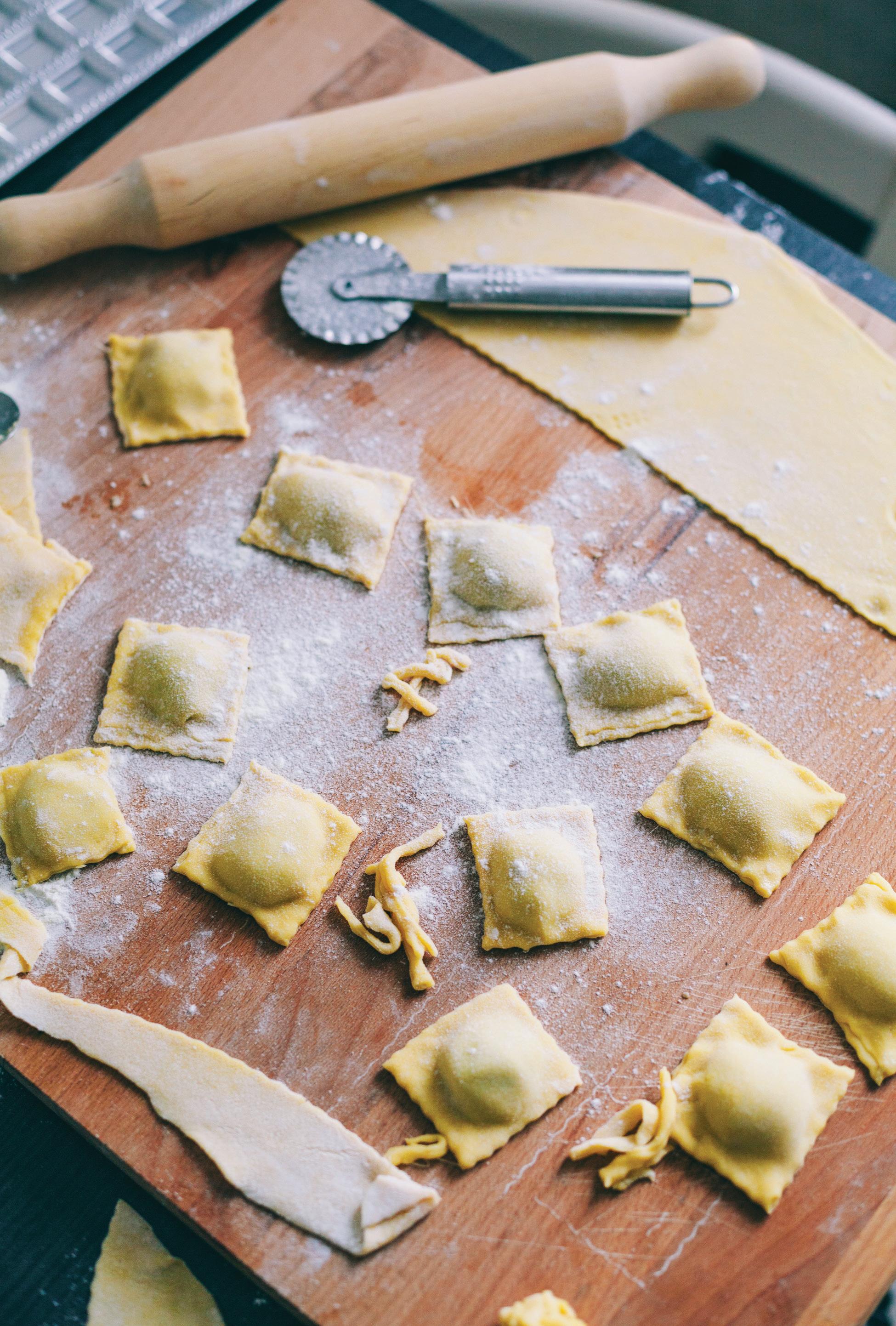
Feeling like trying something different? Here are the ingredients for three other fillings to use in ravioli or other stuffed pasta. Just follow the method in the main recipe.
• Cheese: 2 cups ricotta, 2 eggs, 1 cup shredded Parmesan, 2 Tbsp chopped herbs, salt and pepper to taste.
• Gorgonzola: 1 cup ricotta, 1 cup gorgonzola, 2 eggs, ½ cup shredded Parmesan, salt, pepper and a pinch of nutmeg.
• Potato: Start with 2 cups of very smooth mashed potatoes flavoured with salt, butter and cream. Then add anything else you like: shredded Parmesan and chopped herbs; cooked crabmeat with lemon zest; minced prosciutto; sautéed minced mushrooms with caramelized onion; roasted garlic and leek.
At end dive restaurant, Kara Martyn’s basic egg pasta is made with finely milled “00” wheat flour and whole eggs. She notes that you can mix the dough by hand or in the food processor.
• 1 lb “00” flour (such as Anita’s Organic Mill)
• Pinch of salt
• 5 whole free-range eggs
To make pasta dough in a food processor: Combine the flour and salt in the bowl of a food processor and pulse once or twice until mixed. Lightly beat the eggs and add them to the food processor, pulse the mixture just until the mixture clumps together. Remove the dough, pat it into a ball with your hands and place it on a lightly floured cutting board. Knead the dough for 1 to 2 minutes until it is smooth and elastic.
To make pasta dough by hand: Mix the flour and salt together, then dump it on your work surface and make a well in the centre with a high-rimmed glass to hold the eggs. Break the eggs into the well, beat
with a fork and use the fork to gradually draw the flour into the middle until it’s all incorporated.
Knead dough by hand for 10 minutes, using a traditional kneading motion. Press and stretch the dough away with the heel of your hand, then turn and press away again, until you have a nice, smooth, elastic dough. If you push your finger into the dough slightly, it should spring back slowly.
In either case, if the dough is too sticky to knead, add a little more flour a teaspoon at a time until you reach your preferred consistency. If it’s too dry, spritz lightly with water.
Wrap the dough in plastic wrap and let it rest for 30 to 60 minutes. Once rested, the dough is ready to roll by hand or machine.
Roll pasta until it is thin and translucent, then, using a pastry
pasta-rolling machine, cut it into strands or squares to make any number of formed or filled shapes. There are literally hundreds of shapes to choose from, so have fun experimenting.
Dust the pasta lightly with semolina flour so it doesn’t stick together and cover with a cloth so it doesn’t dry out. You can also loosely gather longer noodles into nests or hang them on a drying rack.
To cook fresh pasta: Bring a large pot of salted water to a boil over high heat, then add the pasta. Stir it gently so the pasta doesn’t stick together and cook to al dente — this may only take a minute or two as fresh pasta cooks much faster than dried. Strain, toss with the sauce of your choice and serve immediately.
Serve 4 to 6.

C O U R T R O O M C A S E :



By Joanne Sasvari

The
light-bodied, fruit-forward red
is the
perfect partner for your favourite fall dishes. Why aren’t we drinking more of
Back in 1395, the Duke of Burgundy banned Gamay from his lands for being “despicable and disloyal” as opposed to his beloved Pinot Noir. The grape has never quite recovered.
I mean, when’s the last time you ordered Gamay at a restaurant, or even found it on the wine list? Yet Gamay is one of the most delicious, easygoing and food-friendly red grapes out there, one that gets along with charcuterie, spicy foods and game meats alike. It also (usually) thrives in B.C.’s climate, which is more than you can say for Cabernet Sauvignon.
It is, to be sure, a bit of an oddball, a blackskinned grape that produces white juice and results in red wine. (Its full name, fittingly, is Gamay Noir à Jus Blanc.) When it first emerged after the Black Death ravaged 14th-century Burgundy, it was considered a wine of good omen, in part because it is easier to cultivate than the region’s finicky Pinot Noir, ripening earlier and yielding more wine. But after Duke Philip the Bold banned it, Gamay was relegated to the southern part of the region, to Beaujolais, where it has found a happy home in the granite-strewn soil.
it?
Winemakers and sommeliers love it. Gamay is gorgeously fragrant, with mouthwatering acidity and soft, well-integrated tannins. It typically bursts with juicy red fruit flavours — think sour cherries, raspberries, red currants, red plums — but can also have lovely floral aromas and appetizing savoury notes of thyme, tarragon and earth. Though it is at times dismissed as lightweight plonk (thanks in part to the hype around the annual release of Beaujolais Nouveau), quality Gamay, especially from the 10 Crus of Beaujolais, can age beautifully. (Last fall, The Courtney Room hosted a Beaujolais dinner that showed just how elegant and versatile this wine can be; if they do it again, don’t miss it.)
low-intervention bottlings, too. It is delightful served slightly chilled. And because of its high acidity and soft tannins, it pairs well with an astonishing array of foods, including many that don’t typically go well with red wines at all, like salty charcuterie and spicy curries. Among them: every component of your Thanksgiving dinner.
It is, to be sure, a bit of an oddball, a black-skinned grape that produces white juice and results in red wine.
Gamay can also grow well in marginal climates like Canada’s, which makes it even more surprising that more of it isn’t grown here. The tiny amount planted on Vancouver Island seems to disappear in blends and bubbles. We can only hope that one day some enterprising winery brings the same zeal to Gamay that we’re seeing now for Chardonnay.
Gamay is a grape that works well in blends, rosé and bubbles and, thanks to its forgiving nature, we’re seeing a number of experimental,
Meanwhile, we’re happy to enjoy Gamay from the Okanagan and Similkameen valleys and, well, anywhere, any time we can.
You can easily find several delicious Gamays from Beaujolais at private and government liquor stores, and you’ll be delighted by the price, which is substantially lower than wines from other parts of Burgundy. (If you can’t resist the Beaujolais Nouveau, mark November 21, the third Thursday in November, in your calendar for this year’s release.)
But you can also find a handful of terrific Gamay wines grown right here in British Columbia. Here are five B.C. wineries that make Gamay we love.
Blue Mountain Gamay Noir
This Okanagan Falls family winery has some of the oldest vitis vinifera vines in the B.C., with Gamay that ranges from 12 to more than 30 years old. They produce gorgeous, bright, juicy red fruit flavours, with lush currant notes against a satisfyingly savoury background, a touch of minerality and even a hint of salinity. Complex, yet super drinkable.
Haywire Gamay
Over in Summerland, Haywire makes wines with loads of personality and little intervention, wresting the taste of the terroir from the soil of the organic Switchback vineyard. You’ll find lots of ripe raspberry, plum and blackcurrant here, with hints of floral, mineral and smoky notes.
Orofino Vineyards PTG or Sparkling Gamay
We love whatever John Weber is making at this Similkameen winery, especially when he plays with Gamay. In the past, he’s developed a following for singlevariety Gamay, but the grape has been
hard hit by the cold events of the last couple of years, especially in the Similkameen. As of writing, Orofno was offering a spicy, juicy, super-quaffable Pinot Noir/Gamay co-ferment, as well as a Lambrusco-style sparkling Gamay, perfect for aperitivo hour.
Rust Wine Co. Lazy River Vineyard Gamay 2019
In France, they call light, fresh drinkable reds “glou-glou,” a term that mimics the sound of the wine glugging into your glass. The Rust Gamay is eminently glou-glou. It hails from the desert-like Lazy River Vineyard in Cawston, which produces flavours of tart but ripe cherries and raspberries with a hint of tobacco and black pepper spice.
Lunessence Winery Gamay
What a pretty and interesting wine this is! Harvested from the Summerland lakefront, wildfermented and aged nine months in neutral French oak, it’s surprisingly bold and opulent for this light-bodied grape, with notes of black cherry and just a hint of vanilla and cedar.


—MONTREAL








Turns out that the best time to visit the City of Light — or almost anywhere — is in the off-season.
By Joanne Sasvari
Last November I fell in love with Paris. Which was funny, because although I’d visited France’s capital city many times before, I was never really all that fond of it. I mean, sure, it’s beautiful and a great place to buy a decent croissant or Hermès scarf, but it was expensive and crowded and, well, a bit rude. I’d rather hop a train to Bordeaux or Lyon instead.
But in November, Paris is a different place. It’s dreamy, romantic and friendly, draped in soft mists and, in between showers, gentle sunshine. We meandered slowly about, window-shopping, popping into galleries and museums, stopping for a glass of wine here or some fresh Belon oysters there, exchanging bon mots with Parisians who happily shared their favourite places with us. Now I’m hopelessly smitten with this gracious place.
Seems it wasn’t Paris I didn’t love. It was what we tourists were doing to it.
When people talk, as they do more and more often these days, about regenerative travel, one of the points that is often made is that tourism has to be sustainable for the people who actually live in a destination.
Tourism, of course, brings in muchneeded, much-appreciated revenue, and most people are happy to welcome visitors and introduce them to the place where they live. But overtourism has made life miserable for the residents in some of the world’s most beautiful places.
Indeed, the onslaught of visitors has driven some destinations to take desperate measures.
Amsterdam, for instance, is telling “nuisance tourists” — mainly young weekenders looking for weed and prostitutes — to stay away. Last summer, despite the 40°C-plus heat, Athens was so overrun it had to cap visitors to the Acropolis at 20,000 a day. Barcelona
was among the first cities to restrict short-term rentals in an attempt to control visitor numbers in peak season; this summer, frustrated protesters sprayed tourists with water guns and symbolically taped over hotel entrances and restaurant terraces.
But despite what some of the more strident anti-tourism graffiti may suggest, the solution isn’t to stay home. The solution is to travel more responsibly. And that means picking your time and your place.
That might mean looking to smaller, less well-known, less frequently visited communities, many of which are equally rich in cultural and culinary treasures. It might also mean travelling at different times of year, avoiding the busy weekends and summer months, planning your journey for the shoulder seasons of early spring and late fall.
For a destination, this reduces the burden in the busy summertime and







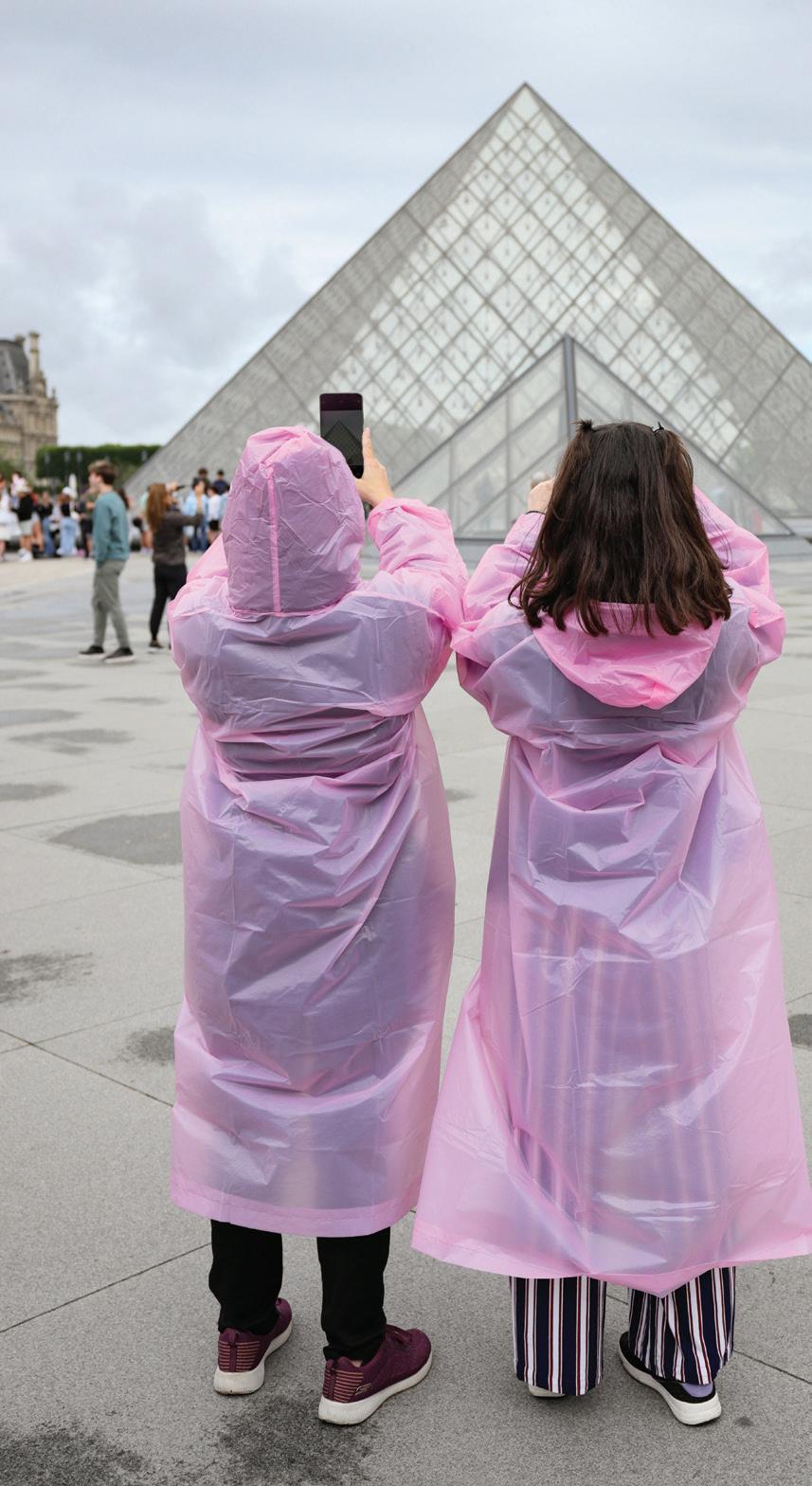
ensures that people have jobs year round. But the benefit of off-season travel is even greater for visitors. The crowds are lighter, it’s easier to get into attractions and restaurants, things tend to be less expensive and, best of all, the people who live in a destination are actually happy to see you.
Doesn’t that sound like a lot more fun?
Which brings us back to Paris. This summer, some 15 million visitors were expected to hit town during the Olympic and Paralympic Games, more than twice the usual number in the peak months of July and August. (However, reports suggest numbers were actually much lower.)
Of course, Paris put on a good show. It is Paris, after all. The city used the opportunity to restore historic buildings like the Grand Palais (at a cost of US$500 million) and commission new art like the statues of women unveiled during the opening ceremonies. It also made the Games the greenest ever, encouraging lowcarbon travel options, cleaning up the Seine and banning single-use plastics, among other initiatives.

Still, I couldn’t help but wonder: Aside from their impact on the residents and the environment, just how authentic an experience would all those millions of wannabe Emilys in Paris have?
We landed at Charles de Gaulle Airport on a drizzly Monday morning and were quickly whisked to our cozy hotel across from the Luxembourg Gardens. Soon after, we were

nibbling baguettes and sipping cafe au lait while our server chatted genially with us. I couldn’t help but compare it to the last time I was here, in June a few years back, when the trip from the airport through gridlocked traffic was both tedious and terrifying, and the servers were far too harassed to pass the time of day.
Over the next few days, we communed with Monet’s “Waterlilies” at the Orangerie without a single tourist thrusting a selfie stick into our sightline. We trekked through a downpour out to the antique mall at Clignancourt where the stall owners had plenty of time to tell us about their wares. We shopped for Longchamp bags at the Galeries Lafayette, where the windows were already festively decorated for the holidays and there were no long, roped-off lineups of people waiting to pay.

Winter is the best time to visit the tiny L’Huîtrerie Régis in the 6ème — oysters are in season, and it’s easier to snag one of the few tables.
One quiet night, we stopped in at Le Willi’s Wine Bar near Odéon, where we leisurely sampled our way through the Rhôneheavy wine list, no need to rush so they could turn the table for a waiting guest. Another night, a friendly Parisian directed us to Les Papilles, a wine shop that serves prix-fixe family-style meals after hours (technically, a “cave à manger”), and joined the neighbourhood regulars dining on fragrant chicken stew from a copper pot. Browsing through the fancy designer shops of the Boul St-Germain, we paused for delicately briny — and perfectly in-season — oysters and elegant Sancerre at the teeny-tiny L’Huîtrerie Régis and didn’t have to wait even a minute for one of the seven tables. Another afternoon, we ducked out of a sudden downpour and into a tabac, a sort of café/bar/corner store, where the server poured us wine and cracked jokes with us like we were old friends.
Everywhere, we met Parisians who were delighted to tell us about their wonderful city. I was heartbroken to leave.
Now, I know it’s not always possible to travel in the off-seasons, especially if you have kids in school, but if you could, wouldn’t you rather?


TRAVEL LIGHT, TRAVEL LIGHTLY, TRAVEL WELL.

560 Yates Street 250-590-6381
2227 Oak Bay Avenue 250-363-9500
adventureclothing.ca

At 20 years young, Victoria’s subversively weird, hilarious and always topical cabaret is anything but all grown up.
By David Lennam
Photo by Jeffrey Bosdet
The difficult part of explaining Atomic Vaudeville to anyone who hasn’t experienced one of the Victoria company’s 87 different cabaret shows over the last two decades is putting into words a three-hour circus of sketch comedy, big musical production numbers, monologues, clowning, standup and utter weirdness, connected by a clever story arc that’s relentlessly topical, sharply clever, darkly subversive and so on point you might be confused about whether this is straightforward spit-upyour-beer funny or some sort of mockumentary skewering whatever you saw on the news that afternoon.
The cult of AV began with founders Jacob Richmond and Britt Small in 2004 and celebrates 20 years as the company prepares for its upcoming Halloween show. Richmond jokes that the underlying philosophy may have been, “How are we going to pay our rent?” but was essentially seeing what they could get away with on stage.
“It slowly created a strong community,” says Richmond, “where an actor with Stratford on their resumé could be sharing the stage with someone who never performed in their entire life.”
Small suggests AV’s longevity comes down to fulfilling a basic need for both artists and audience.
“It’s a way to play with developing work and especially for artists who really are aligned with the idea of art as resistance to dominant culture … It’s a way for people to wrestle with their own lives and experiences and, in some ways, I think we’ve been really good at bringing the outsides to the middle, whether it’s working with queer people or people with different abilities or people who have newly moved here. We take in a lot of strangers in a sense and people looking for community.”
The big productions, featuring 20 or more cast members, are the reason so many performers originally got into theatre. And these days, those opportunities are too rare.

Andrew Bailey, who joined the AV cast on their fourth cabaret, loves that the process of creating each show has a messy, organic quality, featuring a cast that’s always evolving.
“People come and go, stay, go, come back, go again and come back again. It’s people just out of theatre school, people who’ve been doing it for 20 years and people who’ve never done theatre in their lives working together to create something beyond themselves. At its best, it’s community theatre in the best possible sense.”
smart, but deliberately low brow. Underfunded, unloved by the establishment, always waving its arms to flag down the mainstream media.
“It slowly created a strong community where an actor with Stratford on their resumé could be sharing the stage with someone who never performed in their entire life.”
AV has also been an incredible incubator, a first step for actors and comedians to realize that however weird their act was, it was accepted as solid gold on this stage. There are hundreds of alumni, including those who have gone on to — or came from — greatness elsewhere: Mike Delamont, Amanda Lisman, Morgan Cranny, Katie-Ellen Humphries, Amitai Marmorstein, Celine Stubel, Jimbo, Hank & Lily, Brooke Maxwell, Karen Brelsford, Meg Braem, Wes Borg, Ingrid Hansen, Trevor Hinton, Chris Vickers, the late great Gina McIntosh, et al.
And from all those shows came bona fide hits that stood on their own, like the musical The Batshits, the play Legoland and the Broadway darling Ride the Cyclone
I’ve always enjoyed AV’s ability to blindside audiences with comedy that seemingly comes from nowhere, but makes sense. Shocking, but somehow also strangely soothing. Always whip
Richmond, who left the show as head writer in 2020 to pursue other opportunities, figures AV never gained mainstream success because — well, maybe it was just too Atomic Vaudeville.
“We tried to figure out a way to make it not so Little Rascals, but the format rejects anything that isn’t a sprawling anarchic mess. That’s the beauty of it, but ‘a sprawling irreverent anarchic mess’ isn’t going to bring Disney to your door,” says Small.
She laughs about her baby not yet being critically baptized.
“I think it’s like we still have the punk esthetic and maybe that’s what makes us not feel too bitter.”
She figures it’s a missed opportunity for Victoria not to get behind AV and give it the sort of credential Second City or The Groundlings have established elsewhere.
“And fuck the man, things need to change and keep resisting against what isn’t working, which is what art can really do is keep us real. We can get so hypnotized by culture and by everything. You kind of have to punch people in the face every once in a while and go, ‘Hey!’ ”
For upcoming performances, visit atomicvaudeville.com
All the world’s a stage, and fall is the best time to enjoy it.

Until February 16, 2025, Royal BC Museum
Explore the experimentation, innovation and ingenuity behind 100 culturally significant objects created in Canada from the mid-20th century onward. royalbcmuseum.bc.ca
Until October 27, Art Gallery of Greater Victoria Enjoy works by Canada’s greatest artists in this remarkable travelling exhibition curated by the McMichael Canadian Art Collection. aggv.ca
September 4, Save-On-Foods Memorial Centre
History-making hip-hop hero Flo Rida brings his high-energy live show to Victoria, where fans can expect to hear the Grammy-nominated artist play his multi-platinum-certified hit “Low (Feat. T-Pain)” among other favourites. sofmc.com
Rifflandia Festival
September 13 to 15, Matullia Lands
This multi-day, all-ages outdoor music fest is Victoria’s favourite way to wrap up summer. This year sees a new venue in Rock Bay as well as a stellar lineup featuring Feist, TLC, Broken Social Scene, Ja Rule, DJ Rezz and much, much more. rifflandia.com
September 17 to October 13, The Belfry Theatre
When a retired librarian is held hostage by a tough teenager, they discover they have both lost the one thing they have in common. Quebecois playwright Sébastien Harrisson’s award-winning francophone play explores grief, healing and the unreliable nature of time. belfry.bc.ca
The Cult
September 19, Royal Theatre
Get your black eyeliner on — the iconic British postpunk-goth-hard-rock band hits town this month with hits like “She Sells Sanctuary.” rmts.bc.ca
Ron Sexsmith:
Sexsmith at Sixty
September 23, Mary Winspear Centre
The three-time Juno-Award-winning and internationally acclaimed singer-songwriter’s career retrospective showcases songs from his vast catalogue, featuring his unique style that timelessly blends classic pop, contemporary folk and roots-rock idioms. marywinspear.ca
September 25, Save-On-Foods Memorial Centre
A superstar musician, dancer, choreographer and global icon, Paula Abdul has sold 60 million records and won dozens of awards including Grammys, Emmys and Junos. This show might just be straight up the most fun you’ll have all fall — wear your dancing shoes because the stands are going to be jumping! sofmc.com
September 25 to October 13, Langham Court Theatre
Get yourself in the mood for fall’s thrills and chills with this spooky mystery penned by Don Nigro. On a snowy night, a police inspector is called to a remote house to investigate a murder — and encounters the five alluring and dangerous women surrounding the Ravenscroft family. langhamtheatre.ca
September 30, various locations
The National Day for Truth and Reconciliation is a day to mark the impact of residential schools. Various events will be held across the South Island, including the Songhees Nation’s South Island Powwow at Royal Athletic Park, a free event where song, dance and community combine celebration with reconciliation. victoriaorangeshirtday.com, songheesnation.ca/south-island-powwow
Victoria International Wine Festival
October 2 to 6, Victoria Conference Centre
Mix, mingle and sample more than 400 wines from around the world, including this year’s featured region, Rioja. Cheers! vicwf.com
October 6, Royal Theatre
The renowned piano soloist returns to Victoria to tackle one of Beethoven’s greatest works.
Menopause the Musical, October 11

Victoria Symphony also welcomes Cosette Justo Valdés, the newly named artistic director of the Vancouver Island Symphony, to lead this regal program, which will include the music of Johann Strauss, Kodály and more. rmts.bc.ca
October 11, McPherson Playhouse
This musical parody set to classic tunes from the ‘60s, ‘70s and ‘80s finds the hilarity — and there’s plenty to be found — in hot flashes, night sweats and all the special moments of The Change. rmts.bc.ca
Mozart’s La Clemenza di Tito
October 16, 18, 20, 22, Royal Theatre
Political intrigue, mercy, loyalty and the complexities of leadership — this captivating opera has it all as the benevolent Roman Emperor Tito Vespasiano faces betrayal from his closest friends. His struggles to balance mercy and justice are captured in sumptuous arias, exquisite orchestration and a tour de force of dramatic intensity. rmts.bc.ca
October 19 and 20, Crystal Garden
Don’t miss these two annual Victoria Film Festival fundraisers. Art of the Cocktail returns on October 19 with a Roaring Twenties theme. A day later, Crystal Garden hosts Chocolate: A Tasting Event, featuring goodies from more than 40 of Canada’s top chocolatiers. victoriafilmfestival.com
1939
October 29 to November 24, The Belfry Theatre
King George’s first Royal Tour of Canada is set to include a residential school in Northern Ontario. As the students rehearse All’s Well That Ends Well for the King, the actors discover parallels between their Indigenous cultures and Shakespeare’s script — and make his bittersweet comedy their own. belfry.bc.ca

By Joanne Sasvari | Photo by J. Scott Altenbach
If, upon encountering a bat, your first response is a shudder of revulsion, you are not alone. For as long as humans have gazed at the night sky, the flutter of inky wings has whispered to us of things mysterious and unknowable.
In ancient Greece, the bat was considered sacred by Persephone, the queen of the underworld. In pre-Columbian cultures, it was a symbol of supernatural power.
Christian Europe linked it with the devil, evil spirits, witches and, by the end of the 19th century, vampires. In the rational, science-y present day, we worry about the diseases bats might carry.
But we’re still spooked by them.
In truth, bats do us more good than harm. And if any creature is under threat in this
scenario, it’s not us humans.
Bats are the world’s only flying mammals, closely related to primates — indeed, the bones in their leathery wings look remarkably like those in a human hand. There are some 1,400 species of bats on the planet, 16 of them in B.C., nine here on Vancouver Island. They have good night vision, navigate by echolocation, hibernate in winter and eat enormous amounts of flying insects, especially mosquitoes, which alone should make us love them. Only a tiny percentage (0.5 per cent) carry rabies and it is vanishingly rare for diseases to jump from bats to humans.
Bats don’t attack humans; they’d rather be left alone. Humans, however, are doing such a splendid job of eradicating bats that
half of them here in B.C. are considered species at risk. We’re destroying their habitat, killing them with wind farms, poisoning them, contaminating their food sources and letting our pet cats carry out a full-on bat massacre.
One organization trying to save the Island’s bats is the Habitat Acquisition Trust. Among other things, it conducts an annual bat count and educates people about living with bats or best practices for excluding them (because, while we might appreciate bats, few of us would be comfortable sharing a house with a bunch of them).
It also sells bat boxes, so you can offer bats a place to live that’s not your attic — or in the darker corners of your imagination. hat.bc.ca/bats


